|
Aedes excrucians: Woodland Mosquitos are found throughout Canada and are one of our
longest-lived species, flying from May through August. A high-power microscope is needed to
separate them from the more common A.stimulans. This is a female, her antennae are designed
to smell the octenol and nonanal in mammalian perspiration and carbon dioxide from respiration,
her proboscis is tipped with a sheathed drill for biting. Length 8 mm.
| |
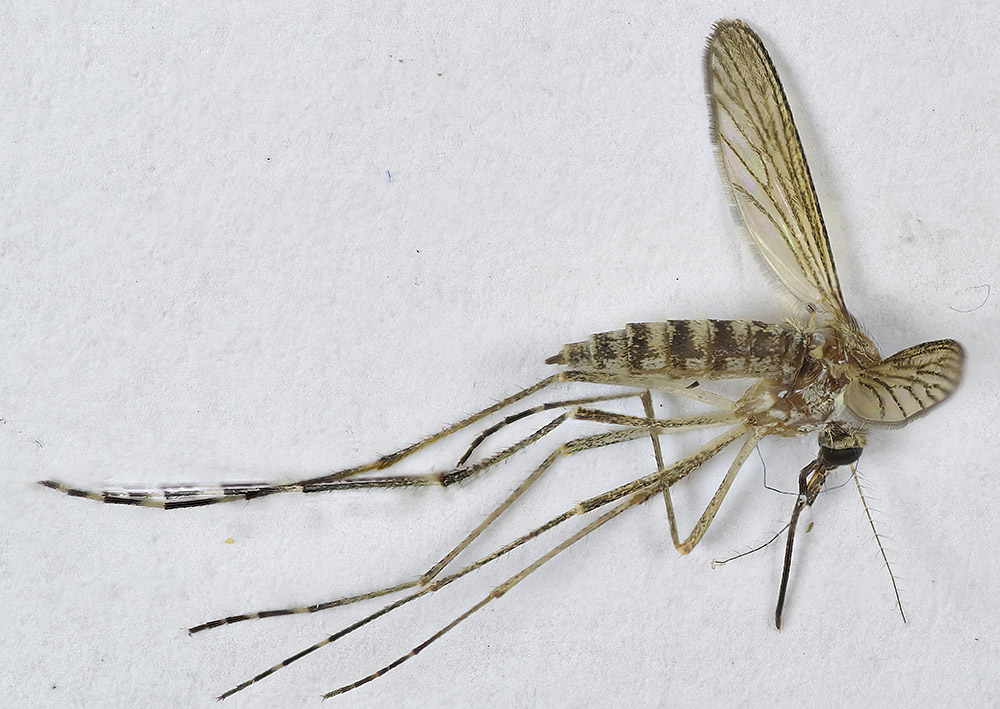

|
|
Aedes sticticus: While taxonomists argue over whether Ochlerotatus is a subgenus of Aedes or a genus in
its own right, Floodwater Mosquitos continue to overwinter as eggs and hatch in the spring to bite us. This is
a male who lives off plant nectar and doesn't bite, his feathery antennae are used to detect the whine of a
female's wings, his long palp to smell her pheromones. Length 8 mm.
| |
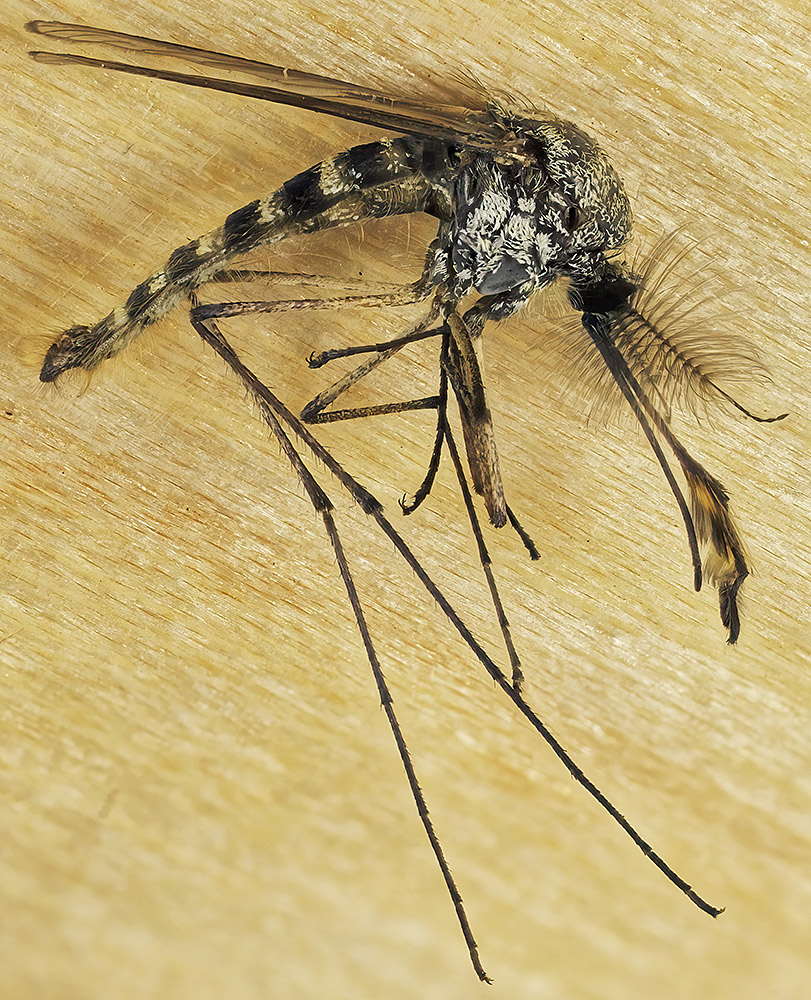

|
|
Agromyza: The larvae of tiny leaf miner flies eat the insides of leaves. Length 2 mm.
| |
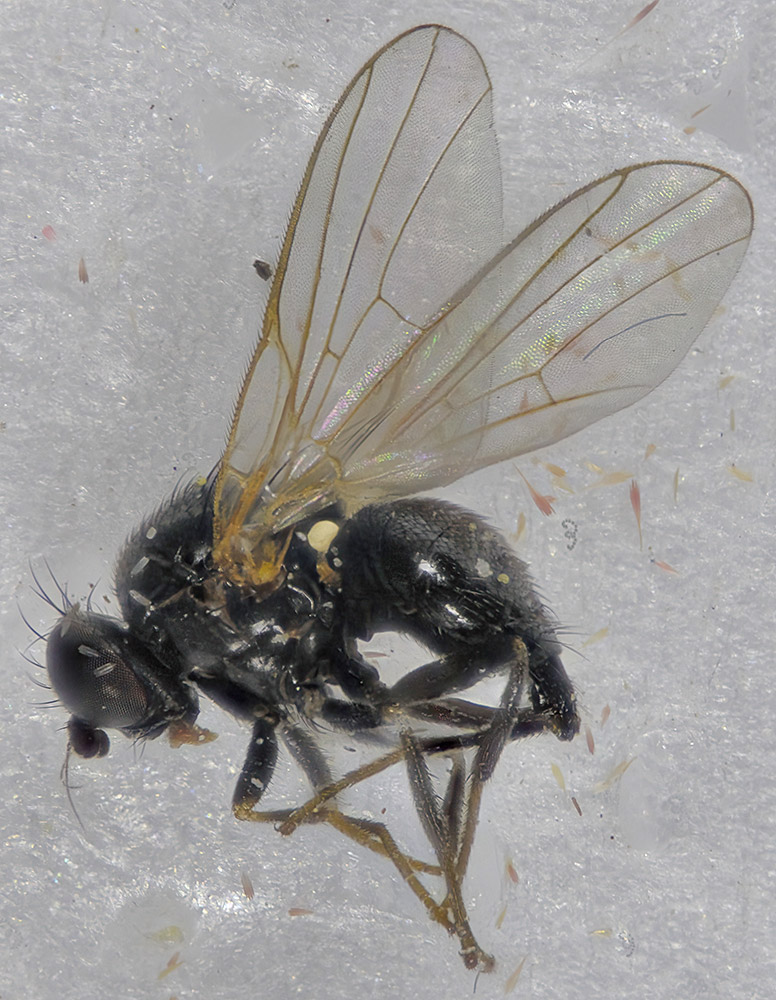

|
|
Anopheles punctipennis: This is one of the most common mosquitos in North America and was a
major vector of malaria here during the building of the Rideau Canal. Body length 6 mm.
| |
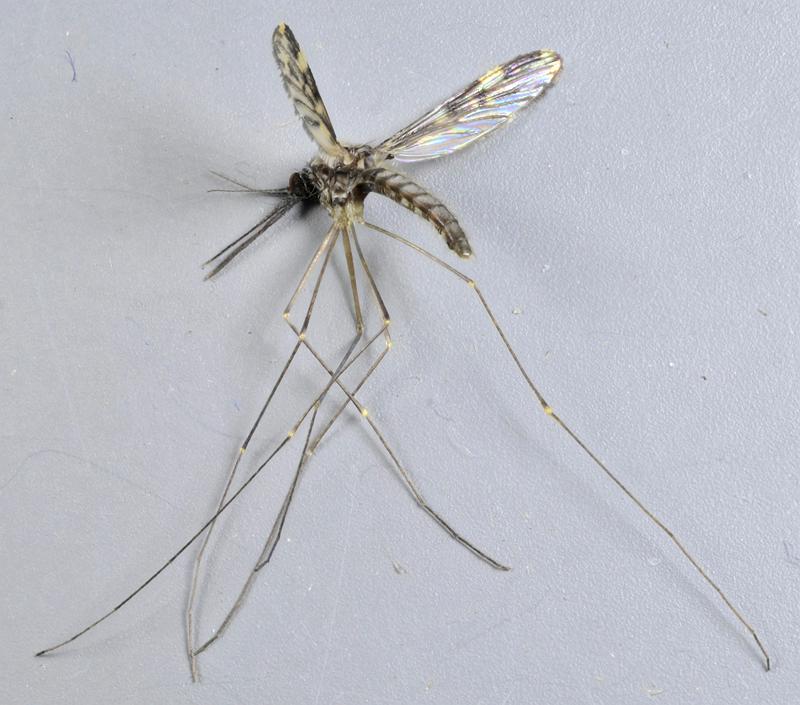

|
|
Archytas californiae: These large tachnid flies are parasites of many crop pests, including forest tent
caterpillar, fall webworm, tomato fruitworm, corn earworm and cutworms. Body length 11 mm.
| |
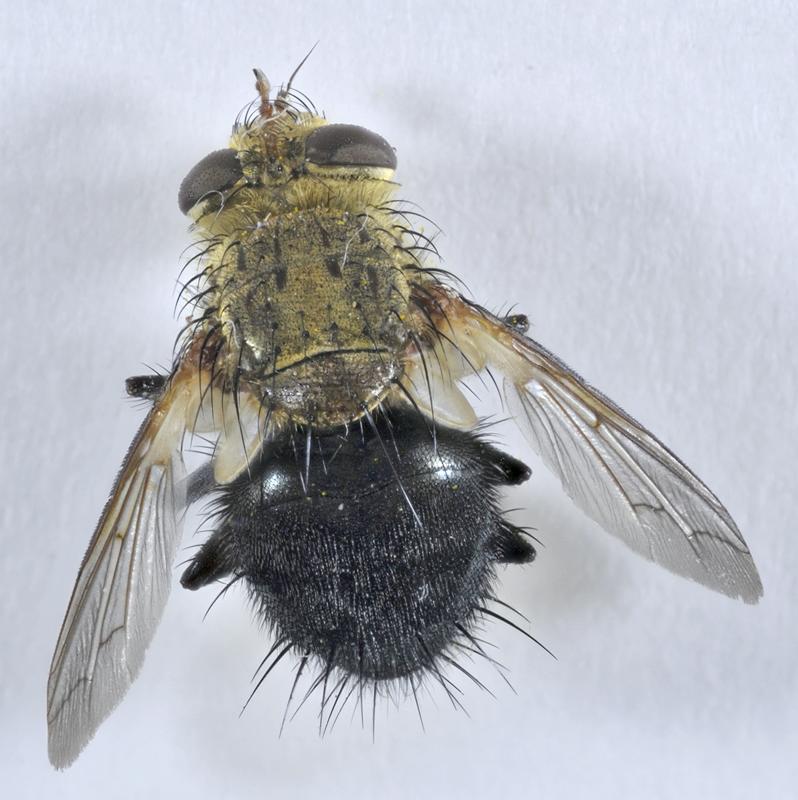

|
|
Bibio xanthopus: March flies have split eyes; perhaps one set is optimized for detecting predators, the
other for mates. Adults are short-lived, most existing solely to reproduce. Their larvae eat grassland plants and
roots. Body length 9 mm.
| |
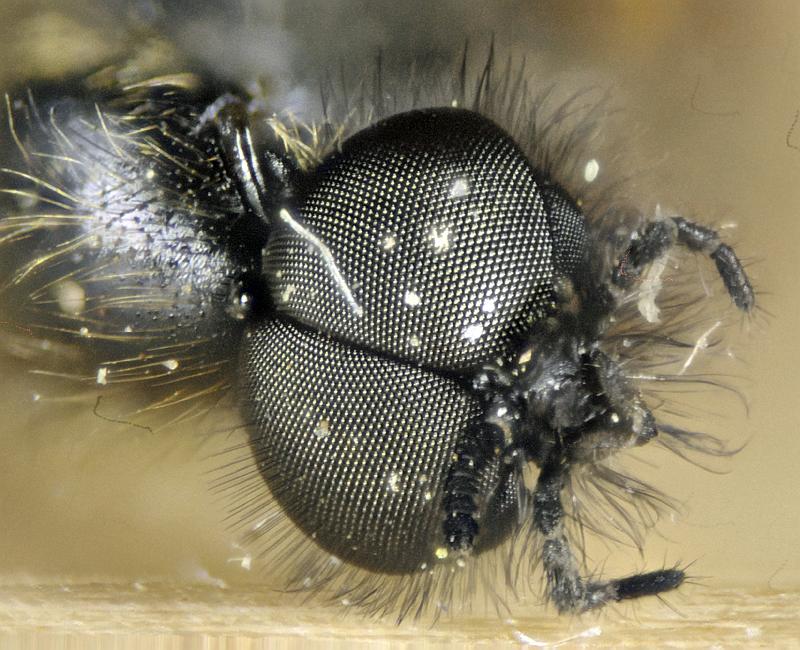

|
|
Bombylius major: This bee fly lives off nectar, in my case Forsythia blooms; it can hover in front of a
flower to feed with its long proboscis. Wing span 20 mm.
| |
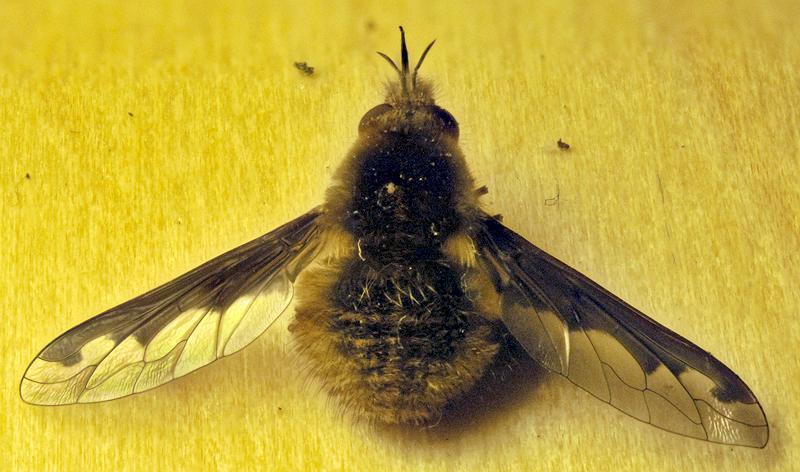

|
|
Borophaga: Nothing is known about these flies - their life must be unusual to result in such powerful
leg muscles. Length 2.7 mm.
| |
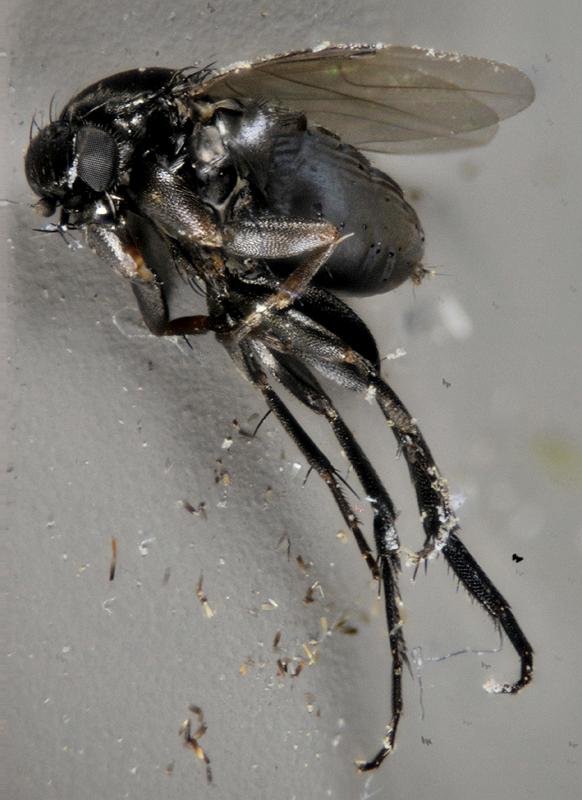

|
|
Calliphora vomitoria: This blow fly feeds on decaying meat and feces both as adult and larva.
Length 12 mm.
| |
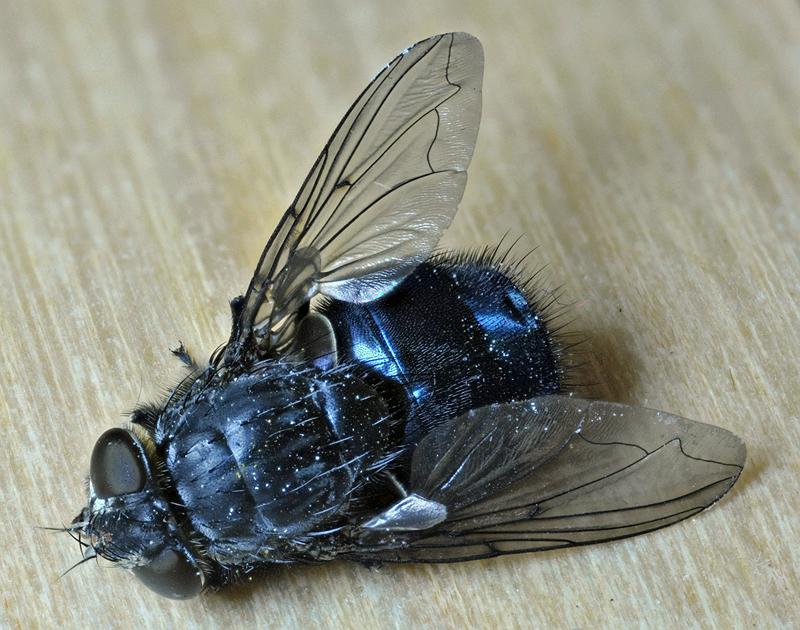

|
|
Camptomyia: This gall gnat's head is literally all eyes! At 300 µm diameter, it
overshadows the rest of the face. As the name implies, the larvae of these flies produce galls. Length 2 mm.
| |
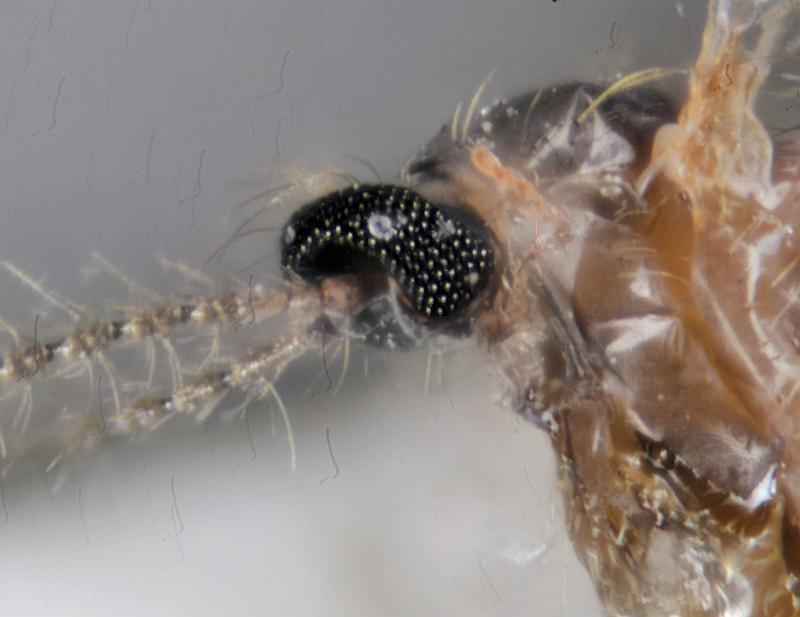

|
|
Chaoborus punctipennis: The larvae of Phantom Midges eat small zooplankton at night and migrate down to
cold dark water during the day; adults live only a few days. Length 4 mm.
| |
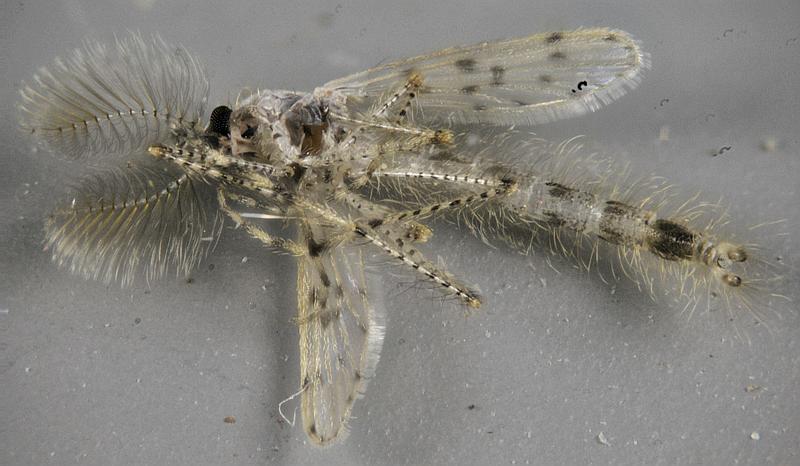

|
|
Chironomus: Non-biting midges found near water that feed on sugars such as honeydew. Their
larvae are an important food source for fish. This one seems to be intersex. Length 7 mm.
| |
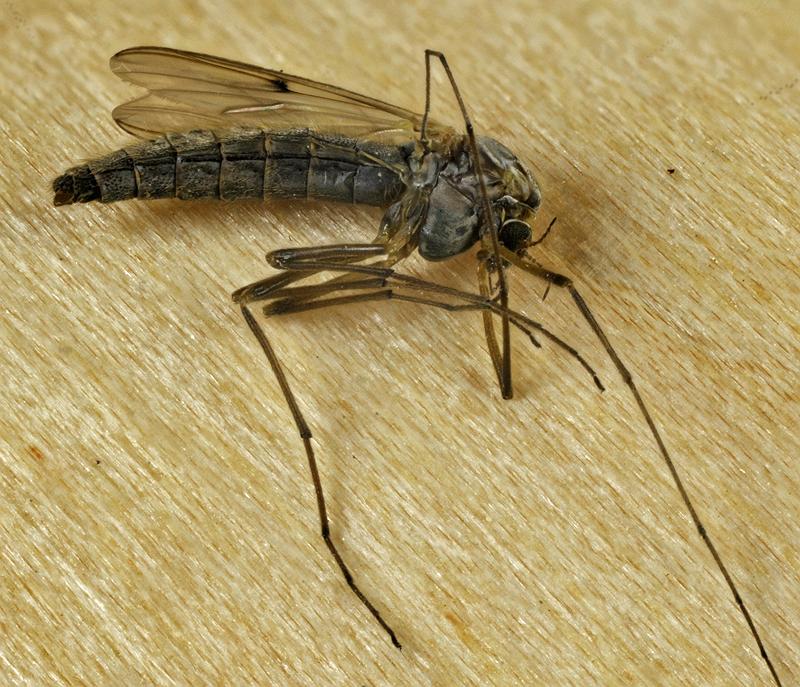

|
|
Chrysopilus quadratus: A long-legged snipe fly whose larvae live in rotten wood. Length 7 mm.
| |
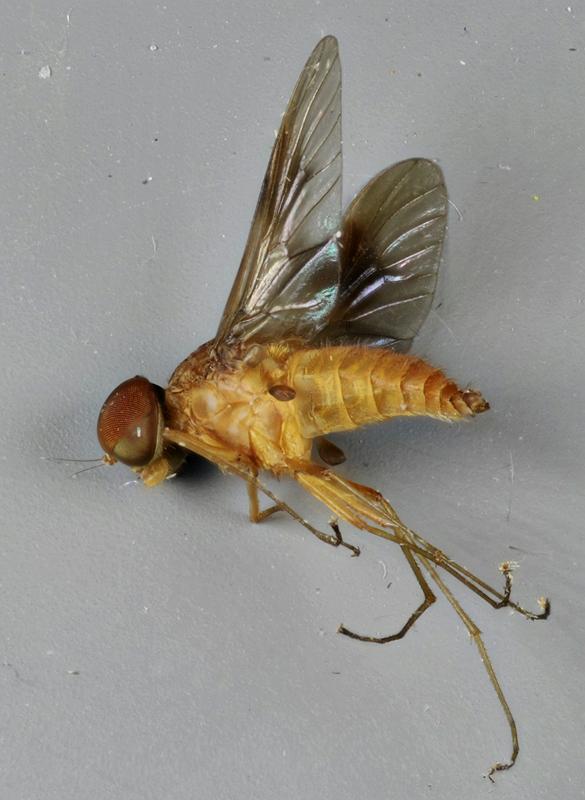

|
|
Conarete: A gall midge. Length 1.9 mm.
| |
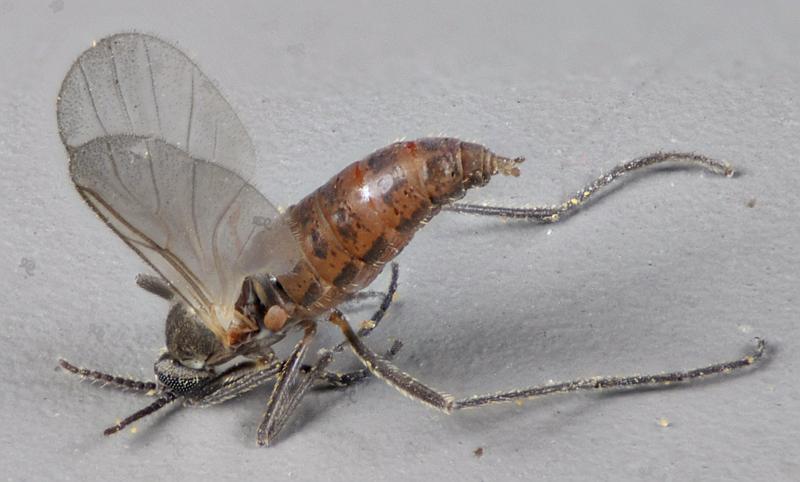

|
|
Condylostylus caudatus: It's believed that this fly is a predator of small insects both as adult and
as larva. Length 3.5 mm.
| |
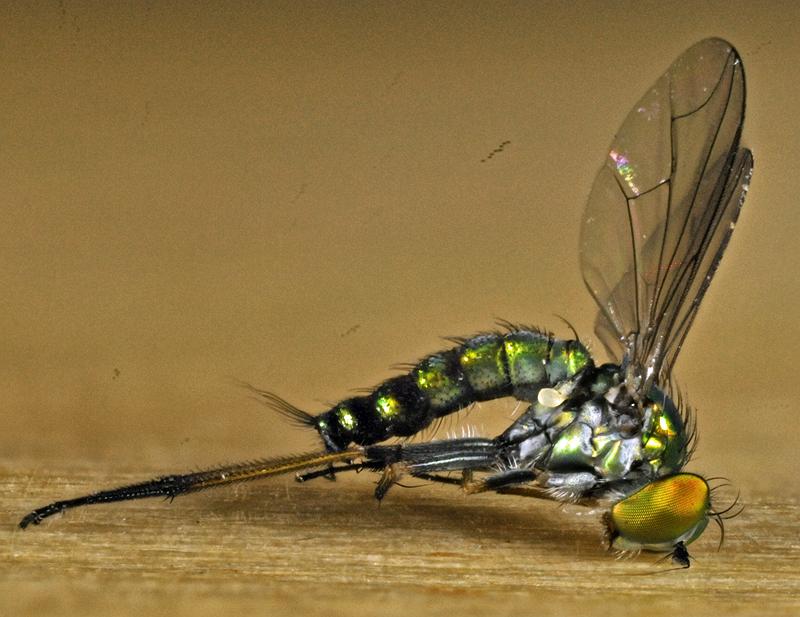

|
|
Condylostylus sipho: Length 7 mm.
| |
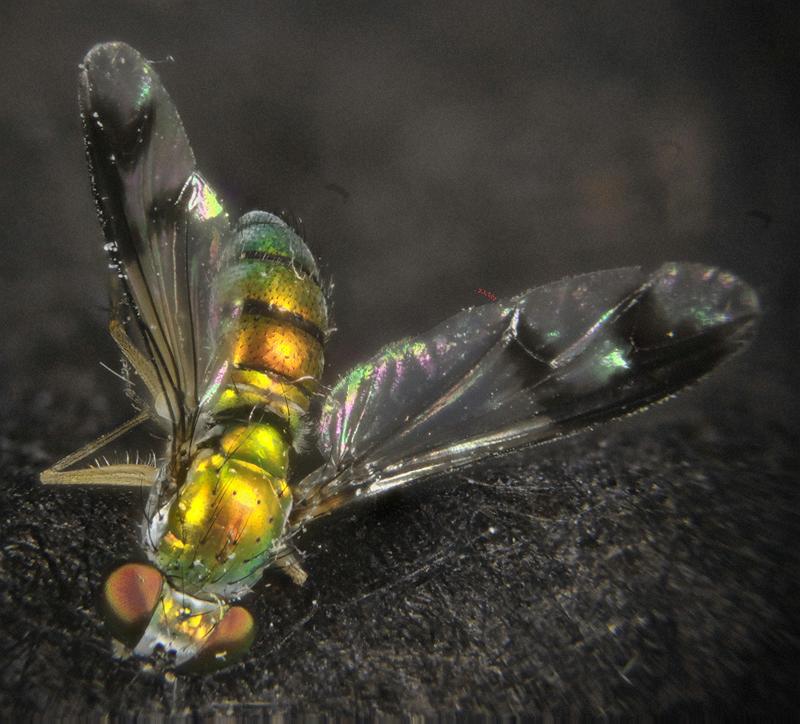

|
|
Coquillettidia perturbans: The larvae of this mosquito can breath through the airtubes of aquatic plants
so they never need to surface for air. Body length 7 mm.
| |
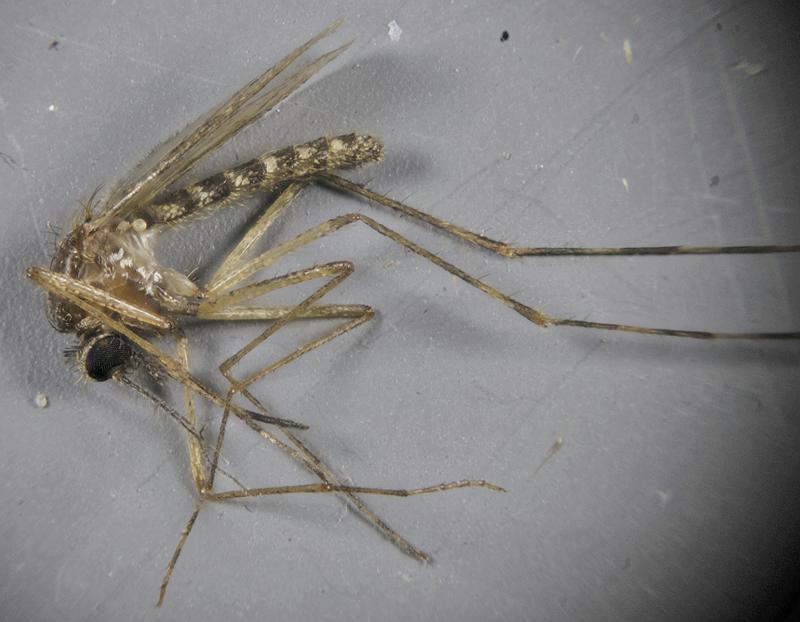

|
|
Cricotopus: Length 7 mm.
| |
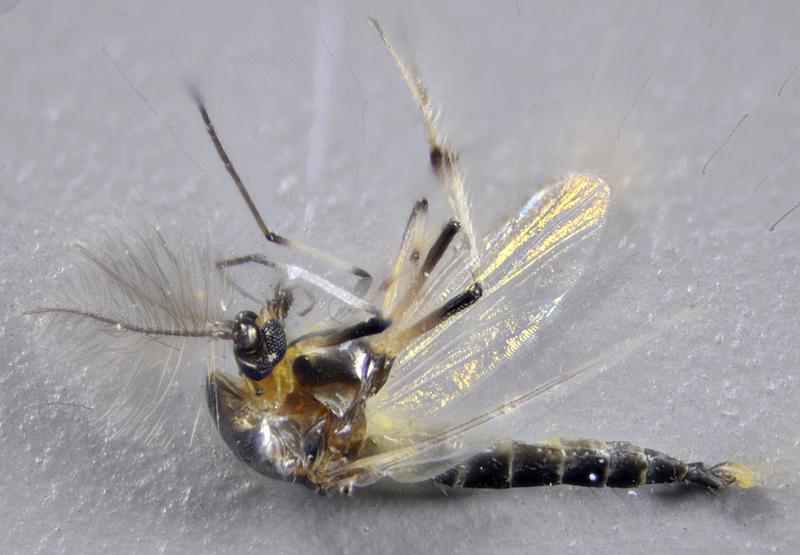

|
|
Cylindromyia interrupta: The bright white calypteres of this tachnid fly stand out. It parasitizes moths.
Length 7 mm.
| |
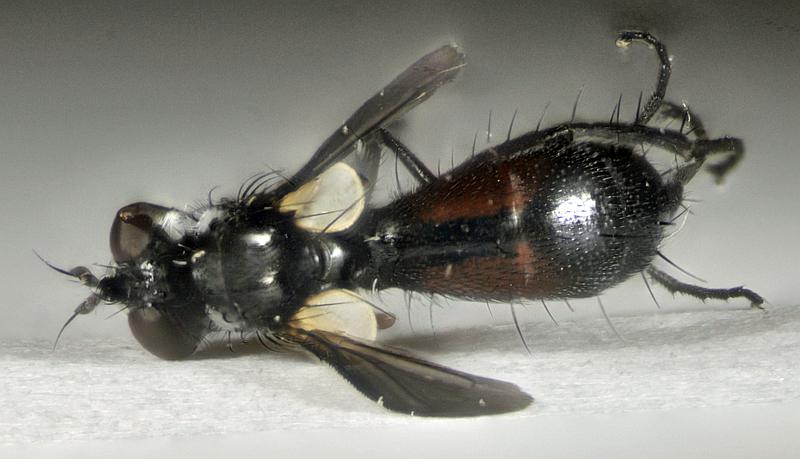

|
|
Dasyhelea: These midges are unusual in that they don't bite but only eat nectar as
adults. Body length 2 mm.
| |
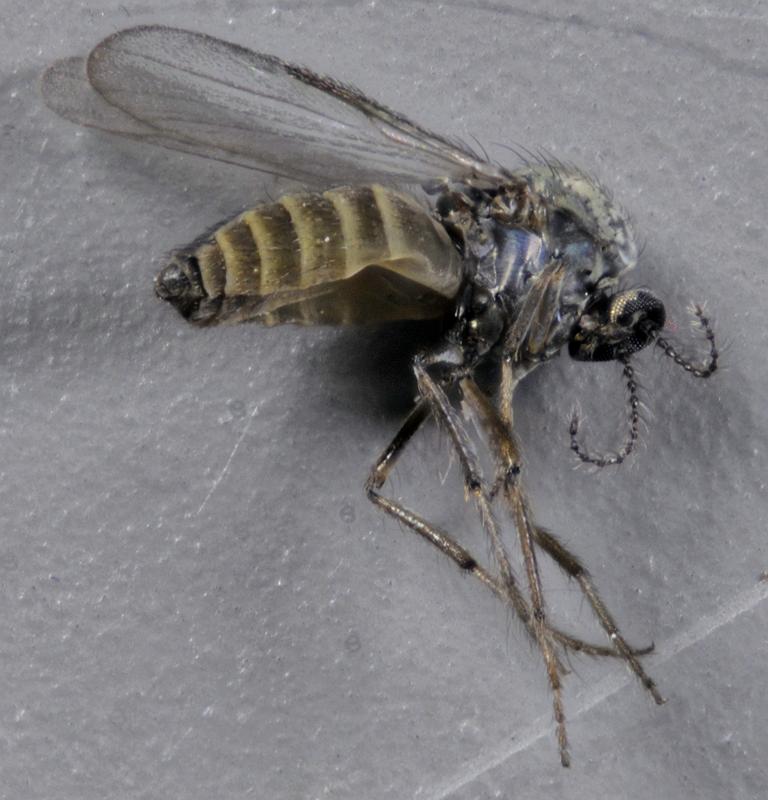

|
|
Delia platura: Seedcorn Maggots burrow into seeds, hence the name. Body length 6 mm.
| |
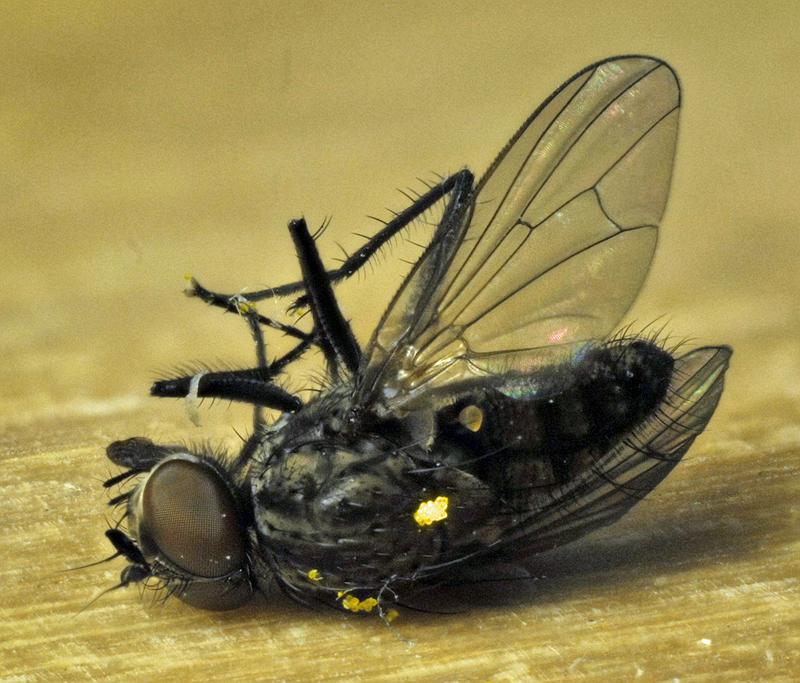

|
|
Dioctria hyalipennis: A robber fly subduing a small wasp for a meal; it's bitten off enough of the wasp's wings
that it can no longer fly, but the wasp has bitten several chunks off the fly in return. Diptera length 10 mm.
| |
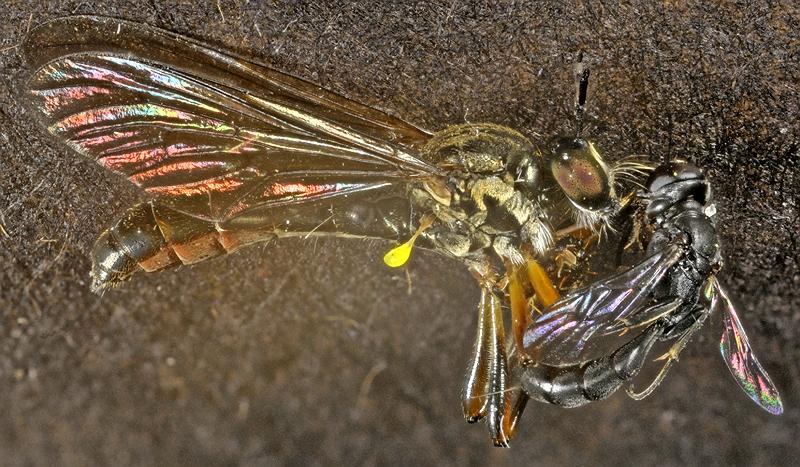

|
|
Dolichopus albicoxa: These little flies choose a leaf with a commanding view of the surroundings, then defend
a litre or two volume around it. They are highly reflective iridescent green from head to tail, appearing as tiny
sparkles over dark leaves, and are the most numerous visible insect in the garden. Length 4 mm.
| |
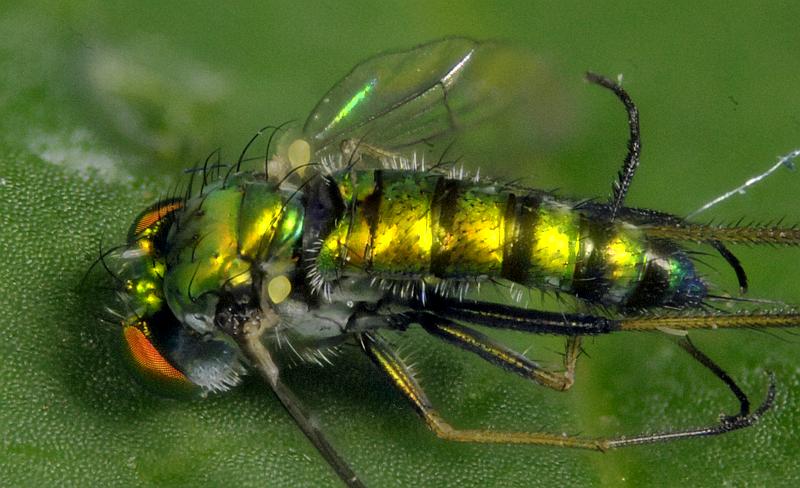

|
|
Drosophila immigrans: This tiny fruit fly is attracted to over-ripe or rotten fruit, but doesn't damage
produce. Originally from east Asia, it has spread world-wide over the past century. It can only survive Ottawa
winters indoors so is rare in the spring; needing only 14 days from laid egg to egg-laying female, it is
abundant by autumn. Length 2 mm.
| |
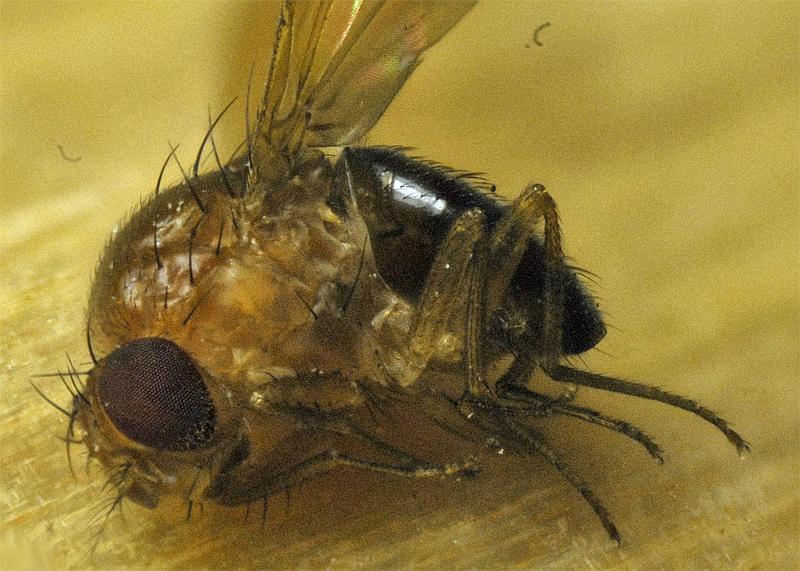

|
|
Drosophila melanogaster: This fruit fly, originally from equatorial Africa but now spread world wide,
is widely used in genetic studies. Length 2 mm.
| |
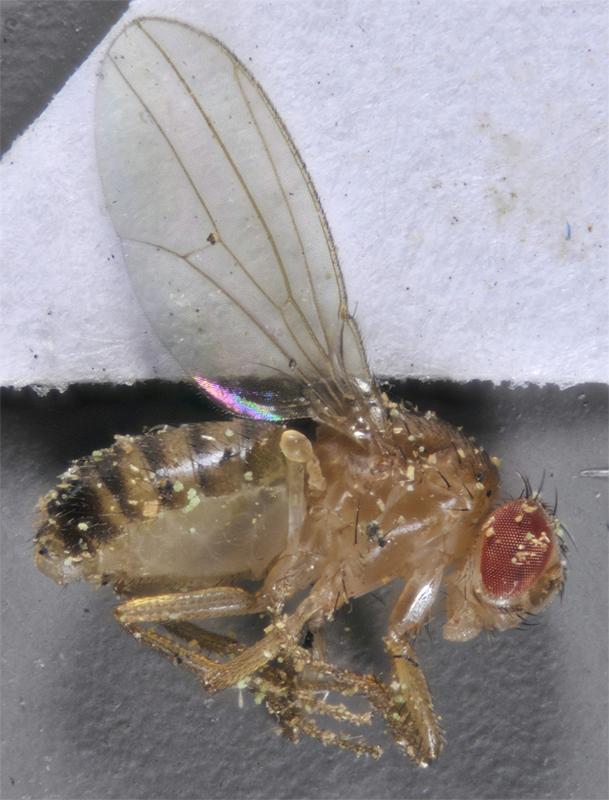

|
|
Eupeodes volucris: The larvae of this syrphid fly feed on aphids and scale insects. Body length 7 mm.
| |
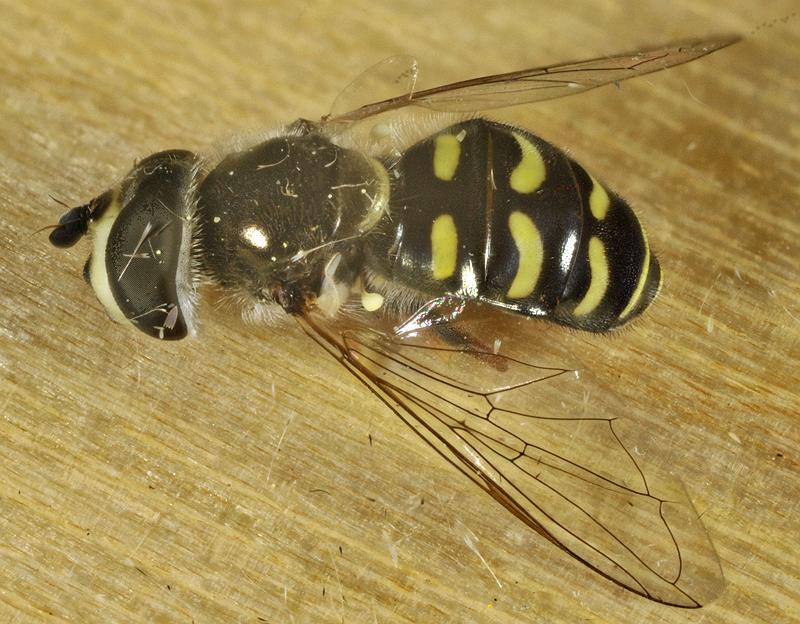

|
|
Forcipomyia: These biting midges are found near water; a Taiwanese species is noted for causing
exceptionally itchy bite reactions. Length 2 mm.
| |
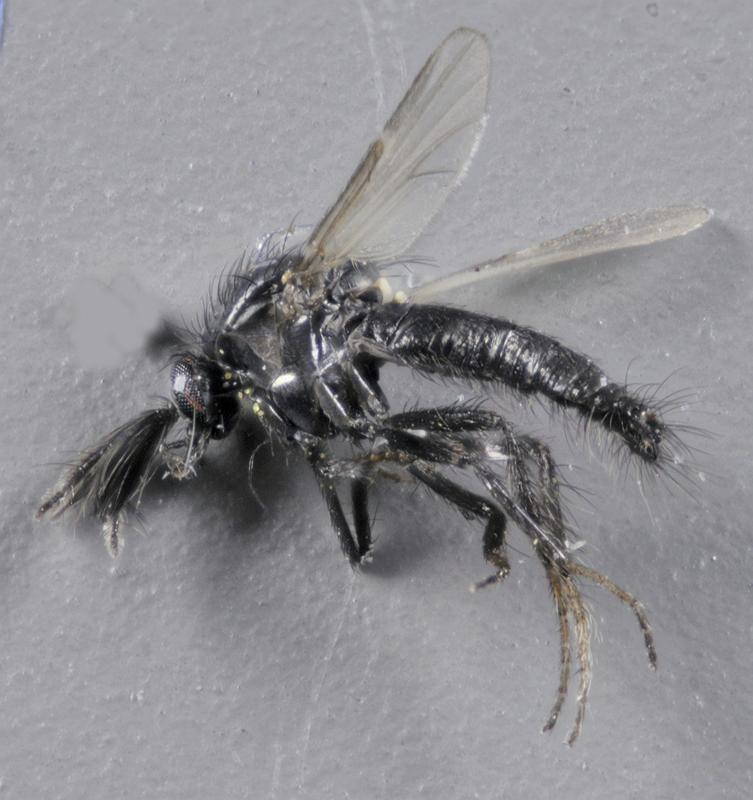

|
|
Glyptotendipes senilis: A non-biting midge that lays its eggs in water. Length 4 mm.
| |
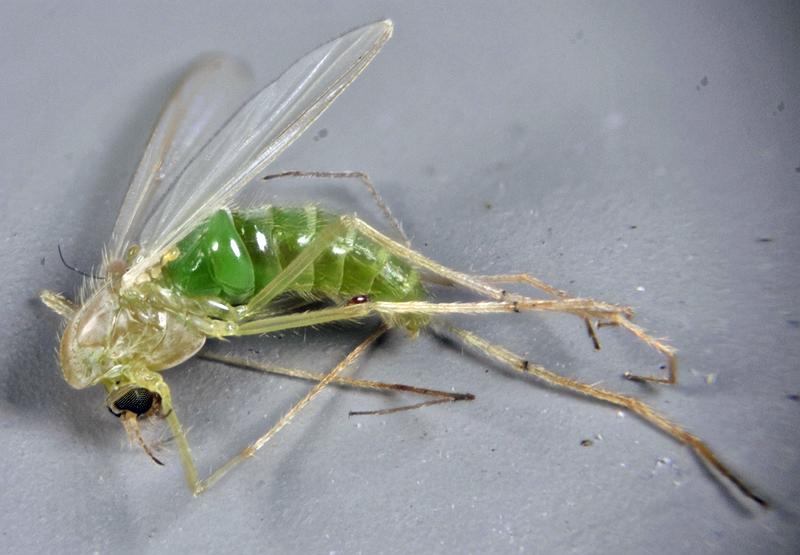

|
|
Gonomyia sulphurella: This female crane fly is infested with Hydrachnidia water mite larvae. Body length 4 mm.
| |
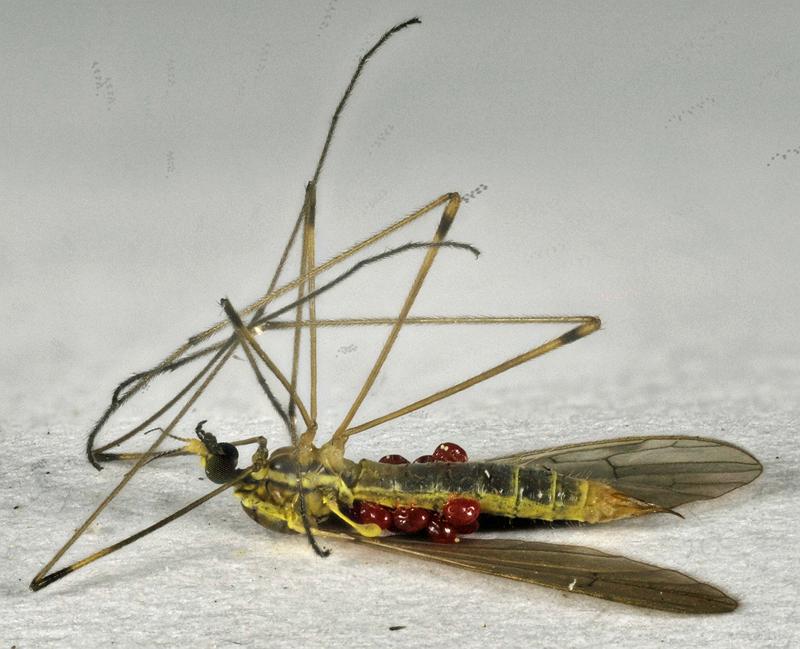

|
|
Harnishia: a group of non-biting aquatic midges with 11-segmented flagellomeres
| |
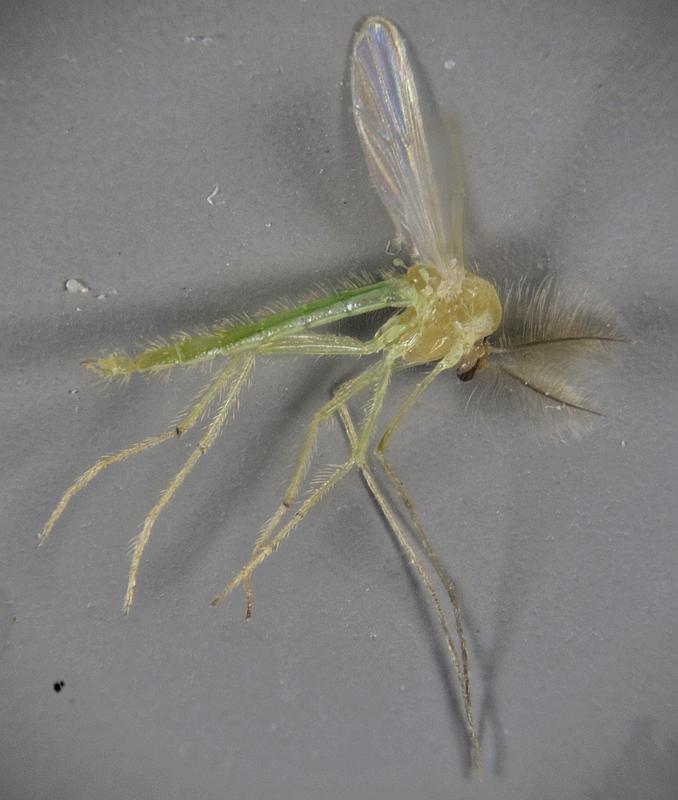

|
|
Helophilus fasciatus: Syrphid flies use mimicry to dissuade their enemies, most looking like stinging
Hymenoptera as this one does. The adults live off nectar and pollen, larvae are aquatic. Length 14 mm.
| |
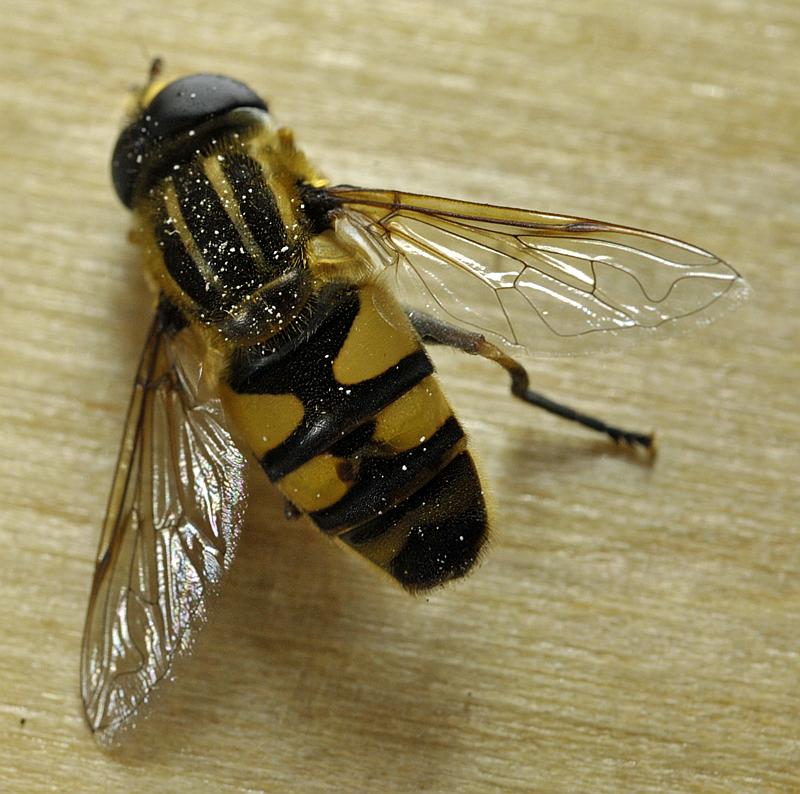

|
|
Hemipenthes webberi: The larvae of this bee fly are parasites on Hymenoptera and Diptera, the adults feed
on pollen and nectar. Length 7 mm.
| |
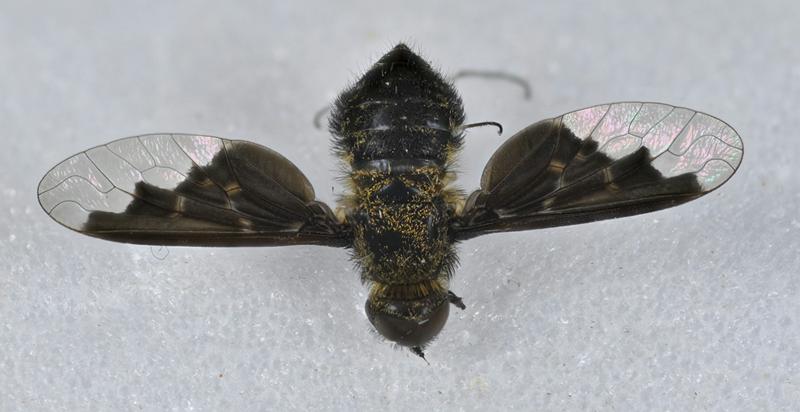

|
|
Heterotrissocladius: These midges resemble black flies but they don't bite. They swarm in large groups of
males waiting for a female to appear. Wing span 6 mm.
| |
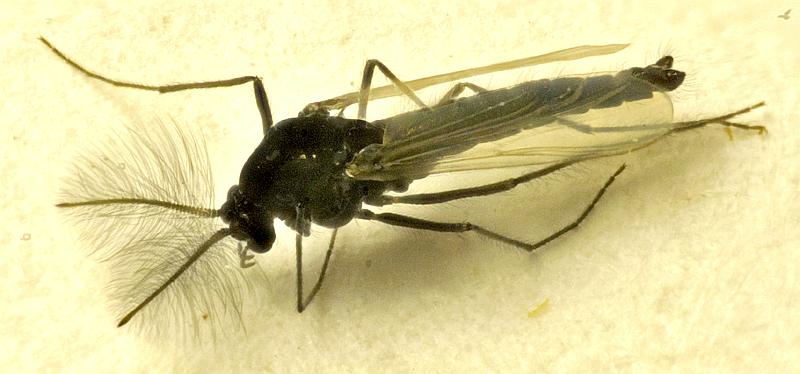

|
|
Hybomitra: One of the horse flies, it gathers in groups hovering above the ground in
shafts of sunlight around the Thuja occidentalis waiting for a female to appear.
| |
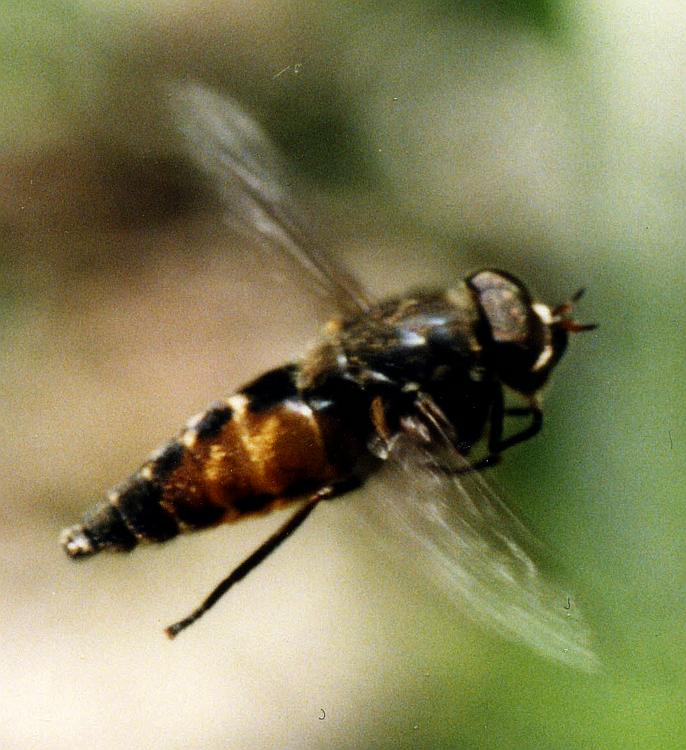

|
|
Hydrophoria lancifer: introduced in the 1920s, this fly breeds on dung.
| |
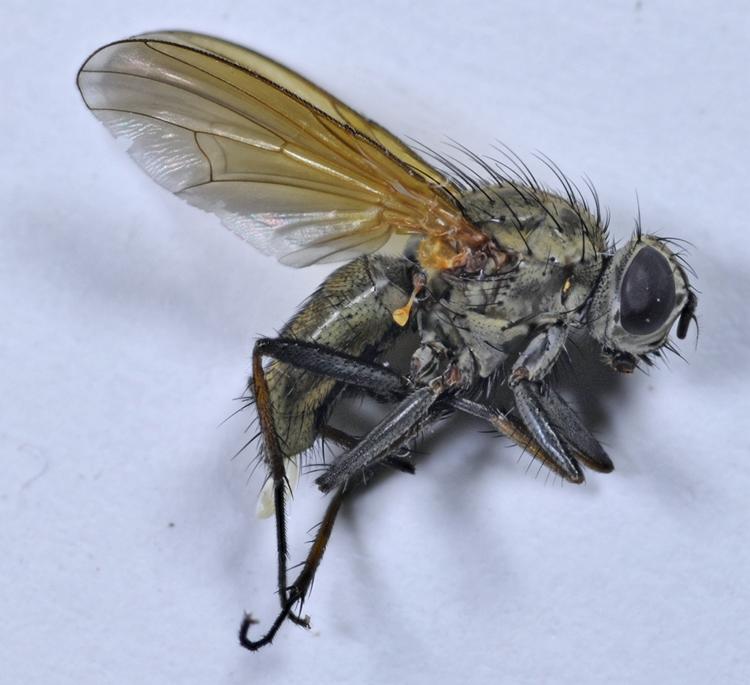

|
|
Leschenaultia: This fly hatched in a rearing jar of top soil that included imported cocoa
shell mulch. Body length 13 mm.
| |
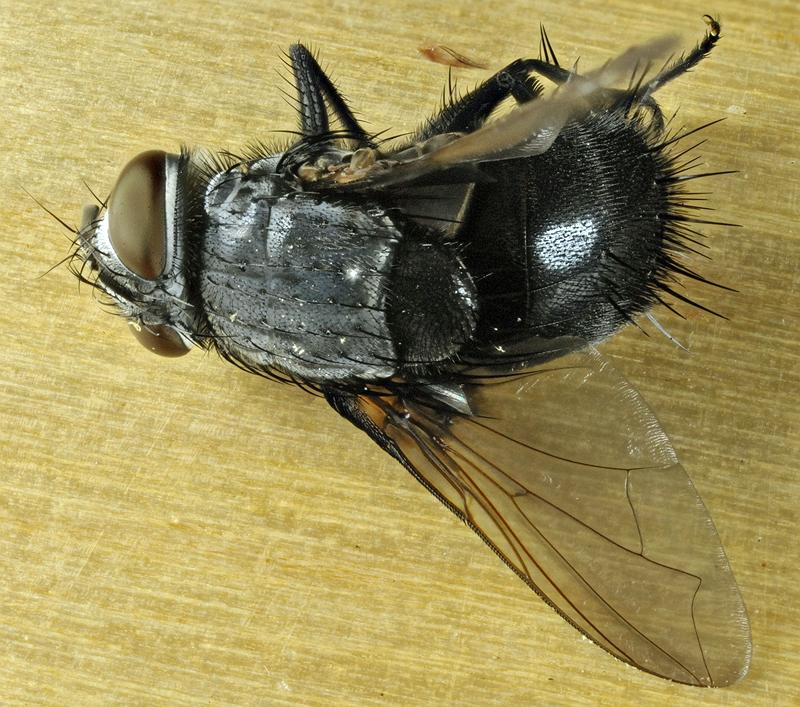

|
|
Leucophora: or possibly Phorbia, in either case one of the Anthomyiidae - root maggot flies.
Length 6 mm.
| |
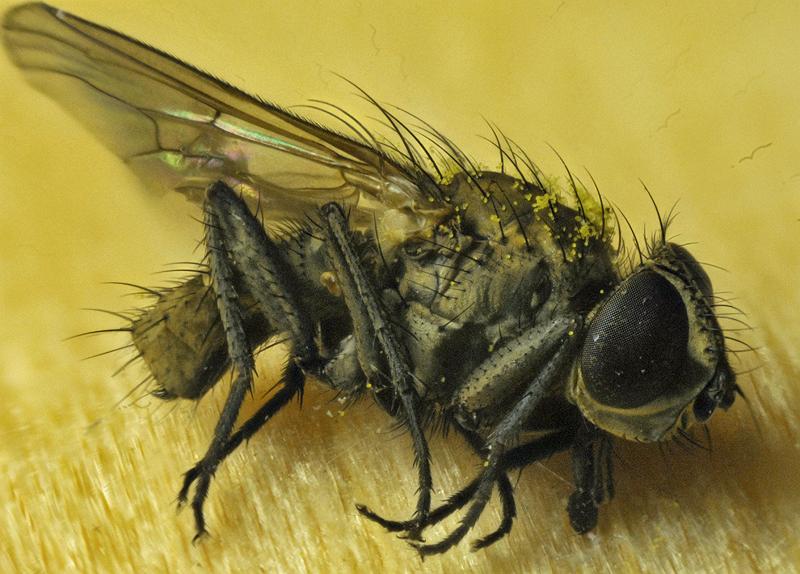

|
|
Lucilia illustris: Blow fly larvae are important recyclers of dead animals; adults can
always be found on Solidago once it is in bloom. Some infest living animals, but this one's larvae
live solely on dead tissue. Body length 7 mm.
| |
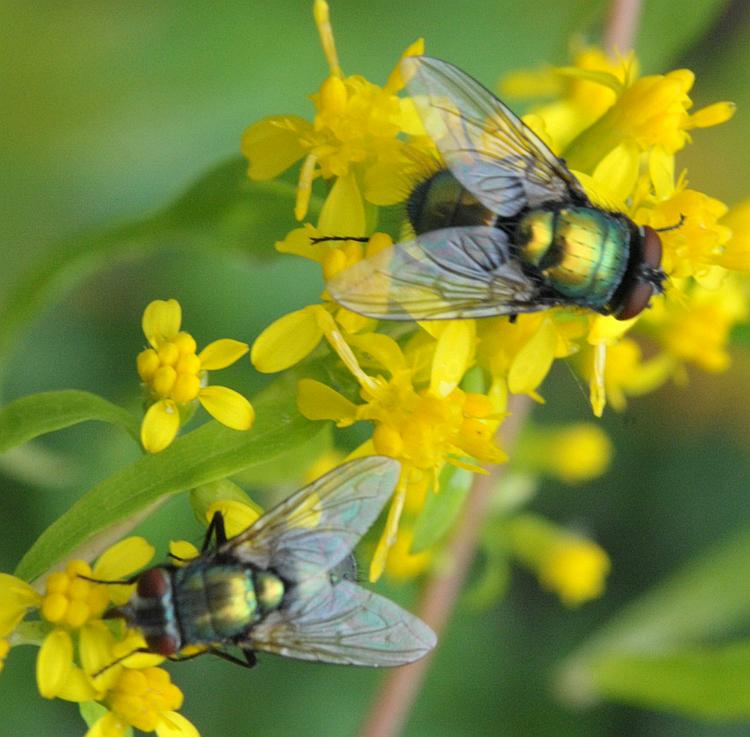

|
|
Megacyttarus (Rhampomyia): These dance fly females swarm to attract males, opposite to usual
dipteran behaviour. Length 4 mm.
| |
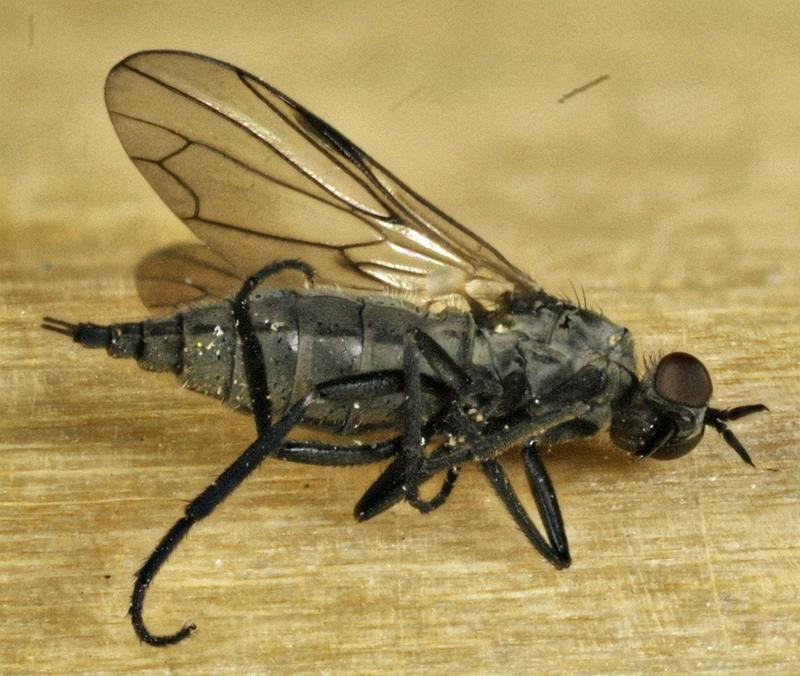

|
|
Merodon equestris: Narcissus Bulb Fly is a European bumblebee mimic that is now found
throughout Canada. As an adult it eats pollen; its larvae live on Narcissus and Lilium bulbs.
Half a dozen of these were jousting over my garden, two facing each other about half a body length
or less, then doing acrobatics keeping their relative position until one couldn't keep up and
backed off - fascinating display. When one is caught in a net, it folds its wings back so they
overlap then produces a high-pitched whine. Length 12 mm.
| |
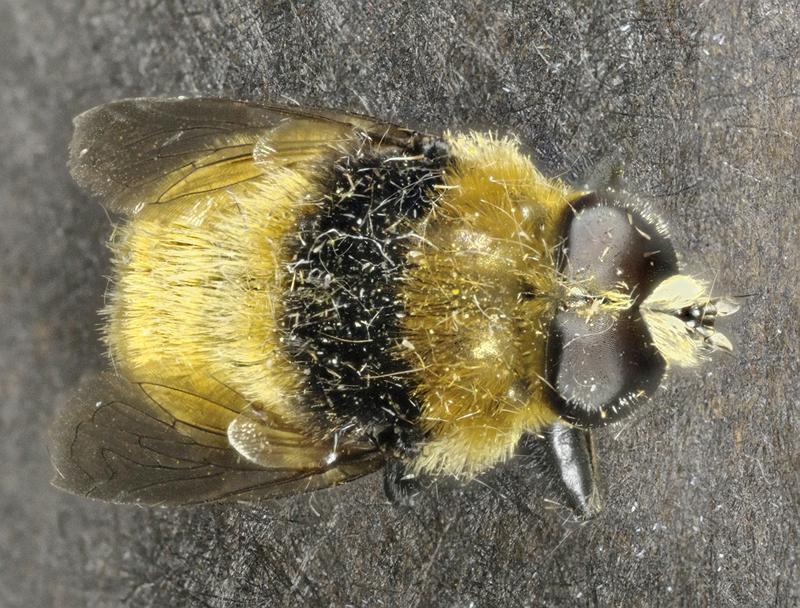

|
|
Micropsectra: A genus of non-biting midges that appear as tiny specks of white fluff when
flying. Length 3 mm.
| |
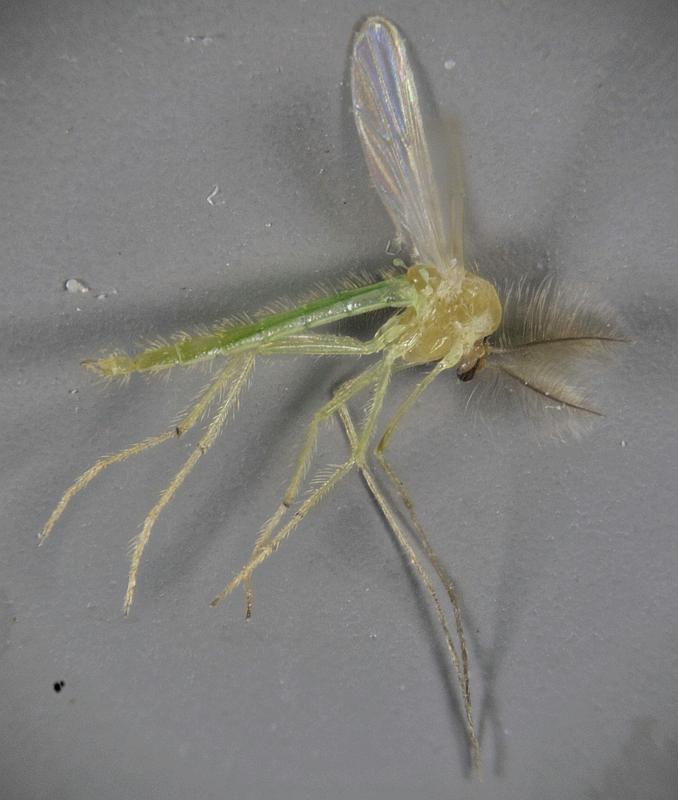

|
|
Nephrotoma ferruginea: This crane fly breeds in the garden. Body length 12 mm.
| |
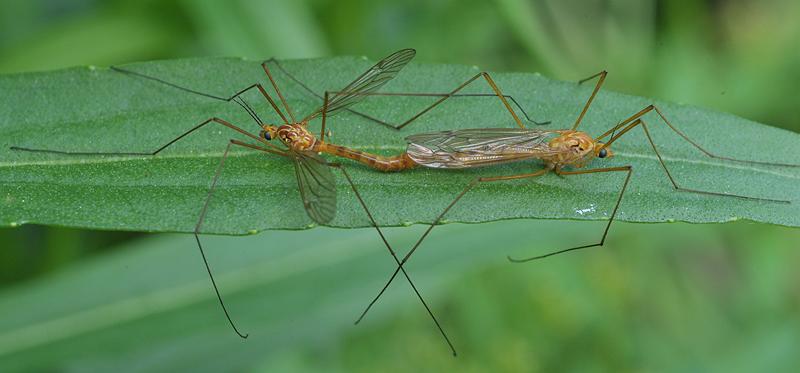

|
|
Omisus pica: A non-biting midge. Length 5 mm.
| |
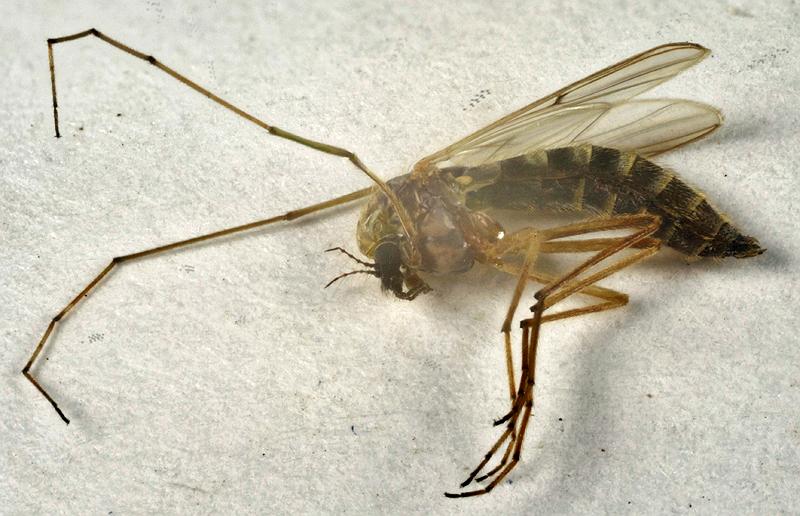

|
|
Paralauterborniella: Non-biting midge whose larvae grow in soft pond sediments. Length
3 mm.
| |
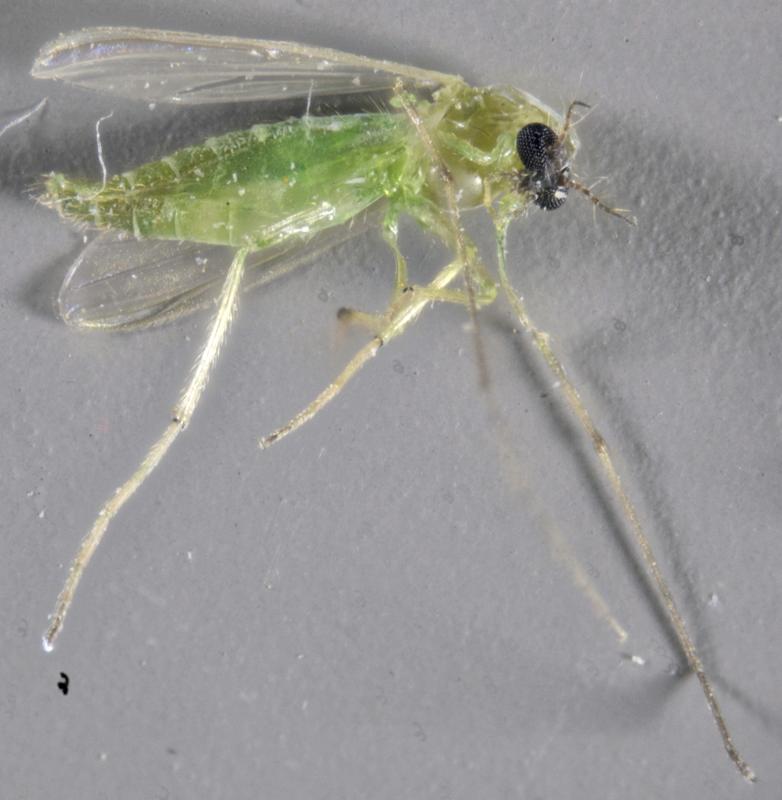

|
|
Phyllomyza: The larvae of several species develop in ant's nests. Body length 2.4 mm.
| |
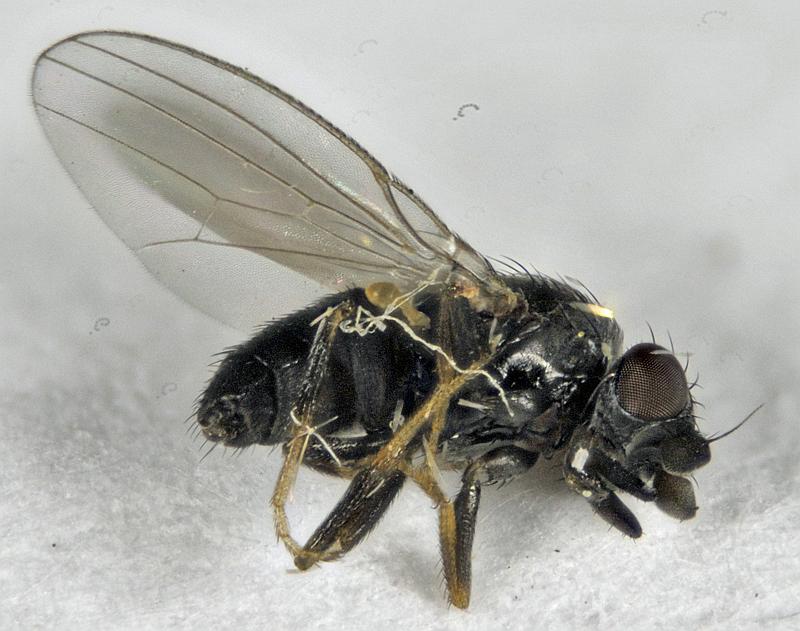

|
|
Phytomyza aquilegivora: These larvae are mining Aquilegia chrysantha leaves. Body length 1.4 mm.
| |
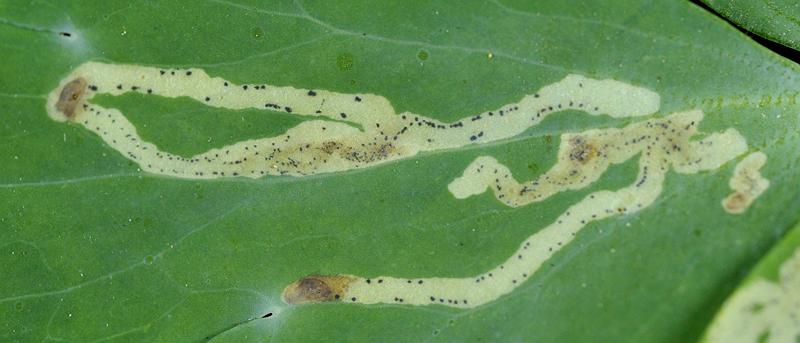

|
|
Platycheirus: This hover fly's eyes cover 360° in all directions. Length 9 mm.
| |
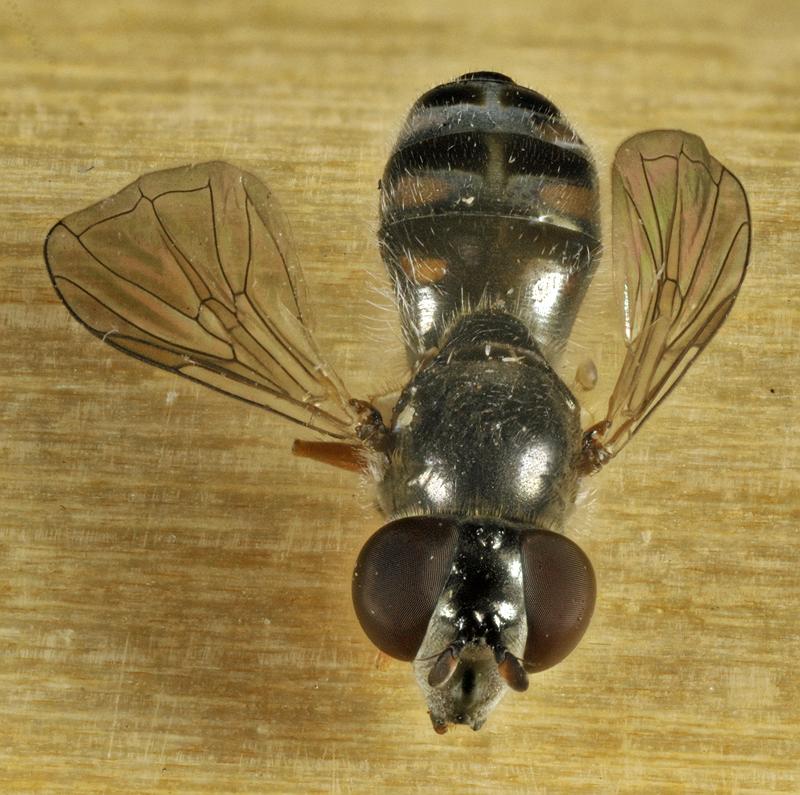

|
|
Poecilanthrax tegminipennis: The larva of this bee fly grow inside Noctuidae larvae.
Wingspan 30 mm.
| |
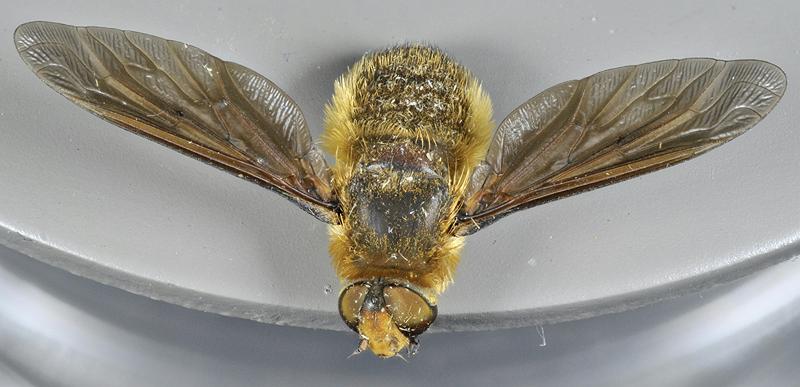

|
|
Pollenia rudis: The Cluster Fly is an import from Europe that can overwinter as an adult
here, so is one of the first flies to appear in spring. It lays eggs in moist soil, then the
larvae burrow to find (European) earthworms on which to feed. The bright light tan calypteres and
orange prothorax hairs help to identify it. Length 8 mm.
| |
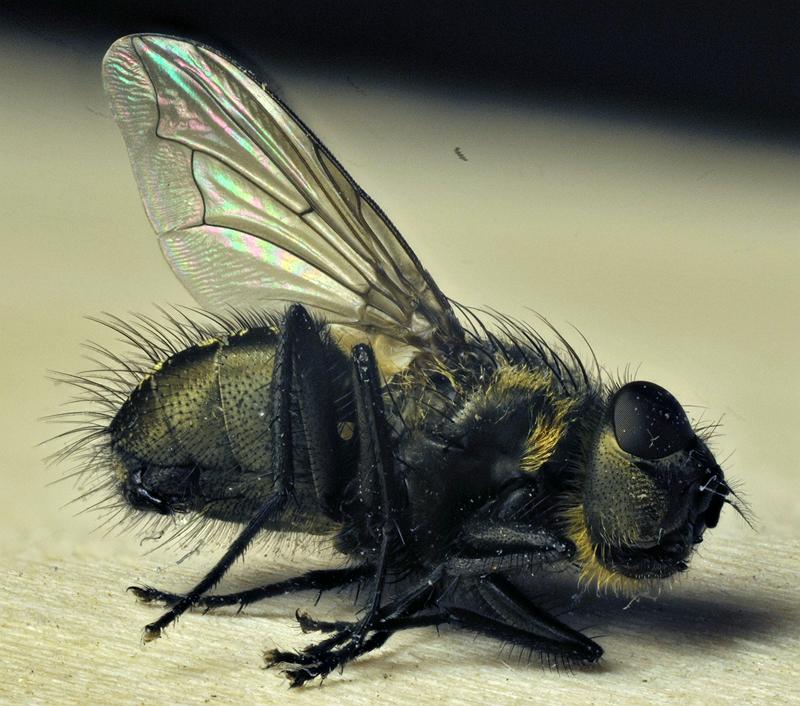

|
|
Platypalpus harpiger: The large mid legs of these flies hold their prey while the fly
feeds. Length 5 mm.
| |
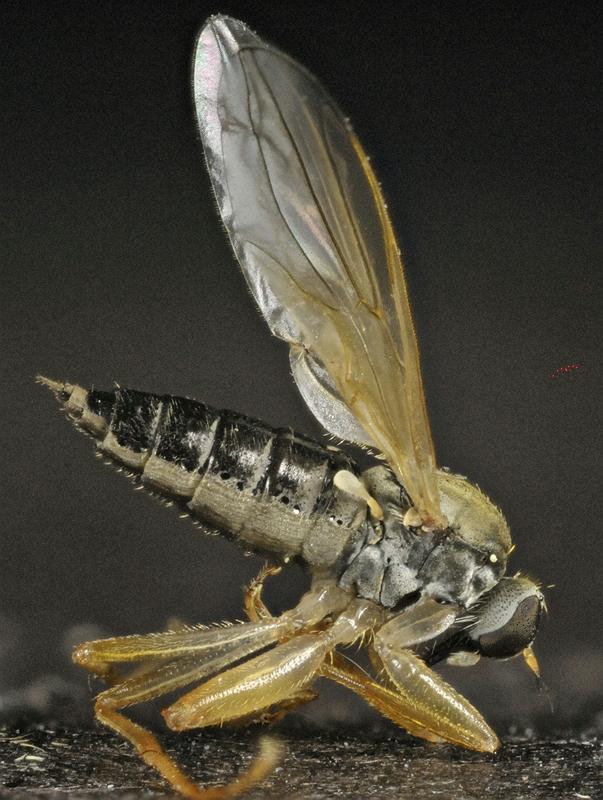

|
|
Procladius bellus: The larvae of this midge eat detritus in the mud of ponds. It's in the
Psilotanypus subgenus. Length 1.7 mm.
| |
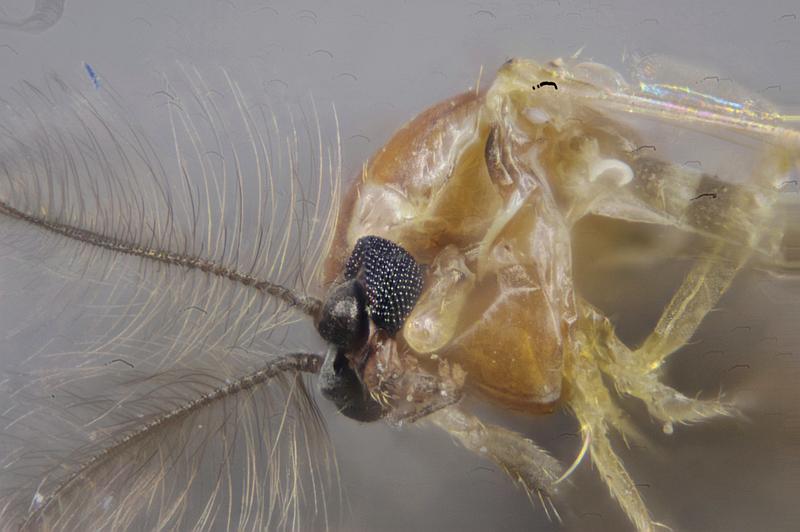

|
|
Procladius: (Holotanypus). The hairy wing shows that it's in a different subgenus than
P.bellus. Length 2.5 mm.
| |
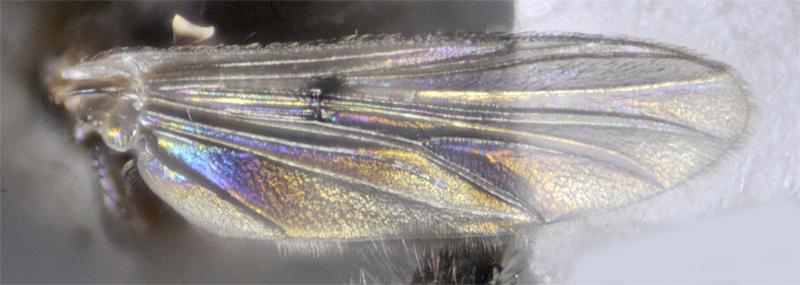

|
|
Rhagio mystaceus: Snipe flies suck plant juices or body fluids of other insects; a few feed
on animal blood. Their larvae mostly live in decaying wood and eat small invertebrates. Length
7 mm.
| |
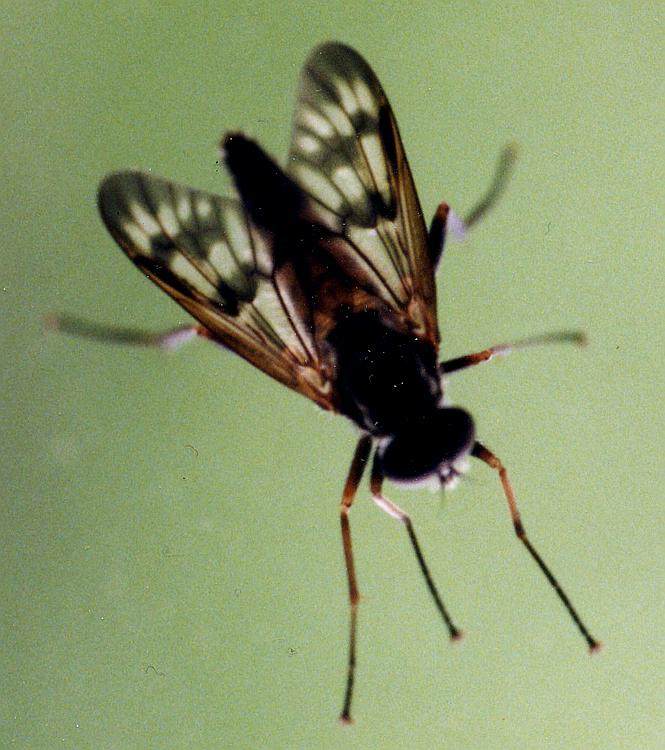

|
|
Schwenkfeldina: A Fungus Gnat is regurgitating a drop of stomach liquid - it will suck it
in again. This is a common behaviour, but no one really knows why. Length 5 mm.
| |
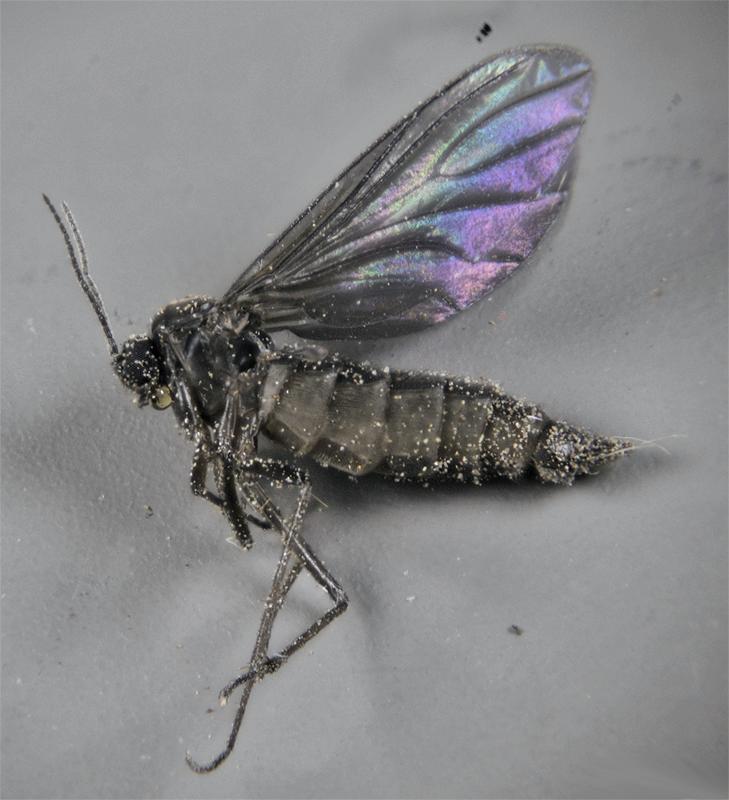

|
|
Sciaridae: Dark-winged Fungus Gnat larvae are common in damp organic soil where they eat
fungi and decaying organic matter, occasionally living root hairs. The adults don't eat or bite,
only living for a few weeks. This one is trapped in a sticky trap indoors. Length 1.7 mm.
| |
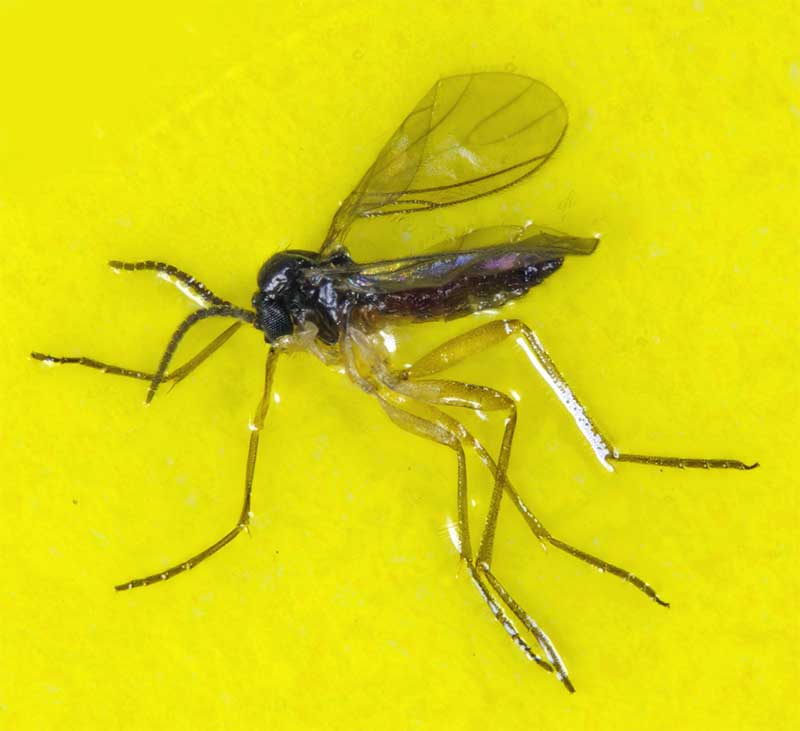

|
|
Simulium: A Black Fly - the tarsal claws of this one identify it as a mammal feeder.
Length 2.1 mm.
| |
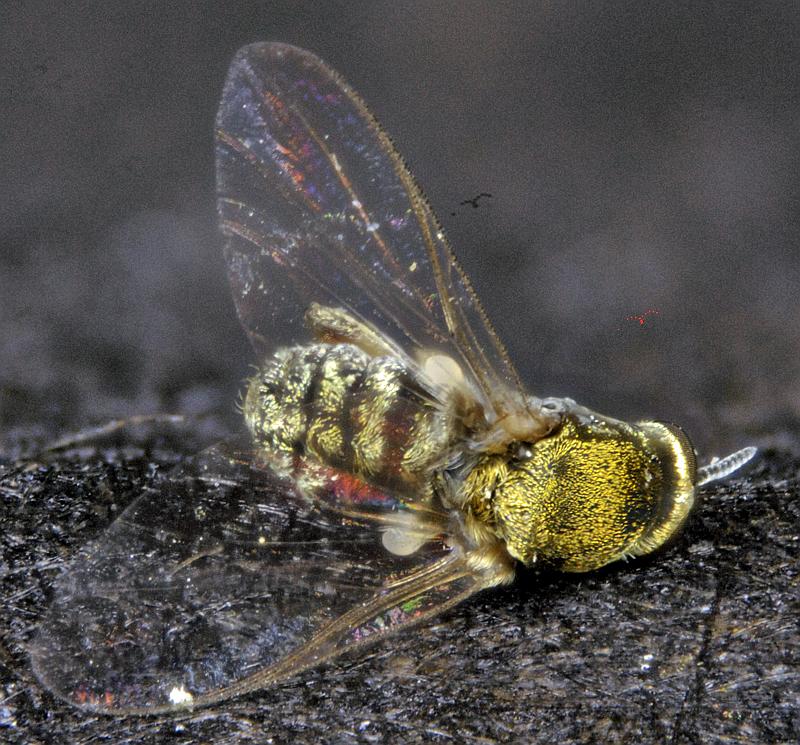

|
|
Strauzia longipennis: Sunflower Maggots bore in the stems of various plants of Asteraceae, particularly Helianthus annuus, and feed on the pith. Length 7 mm.
| |
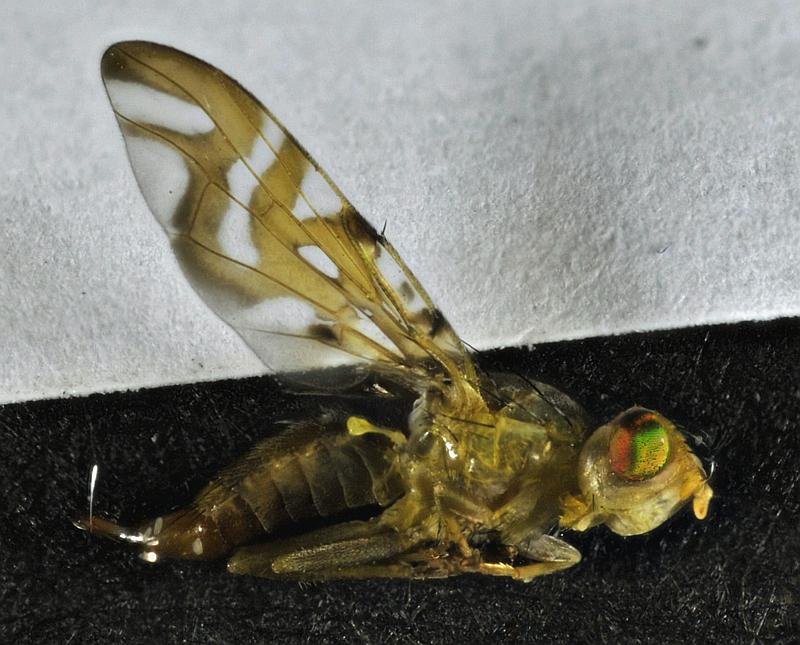

|
|
Tabanus catenatus: Adults feed on nectar and plant exudates; females bite animals to obtain protein from blood to produce eggs. The mouthparts of females are formed into a stout stabbing organ with two pairs of sharp cutting blades, and a spongelike part used to lap up the blood that flows from the wound. Length 30 mm.
| |
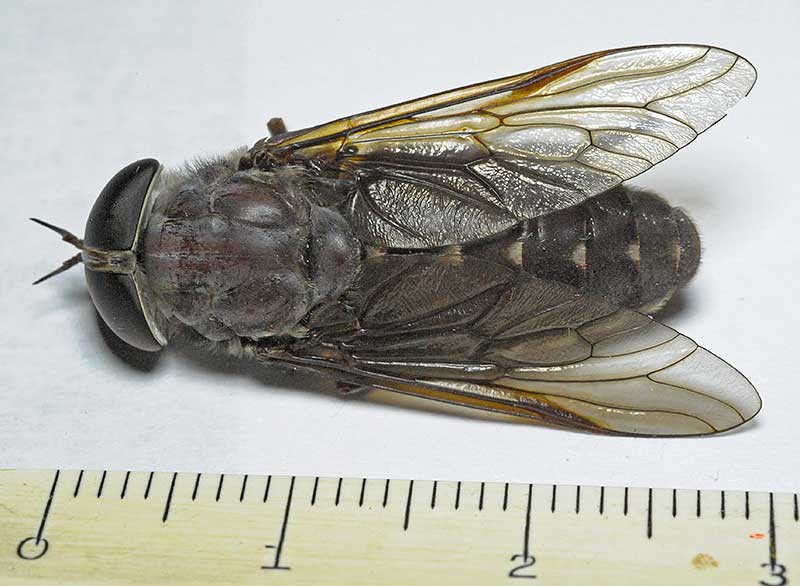

|
|
Thricops nigrifrons: These flies eat pollen; their bright orange calypteres stand out. Length 7 mm.
| |
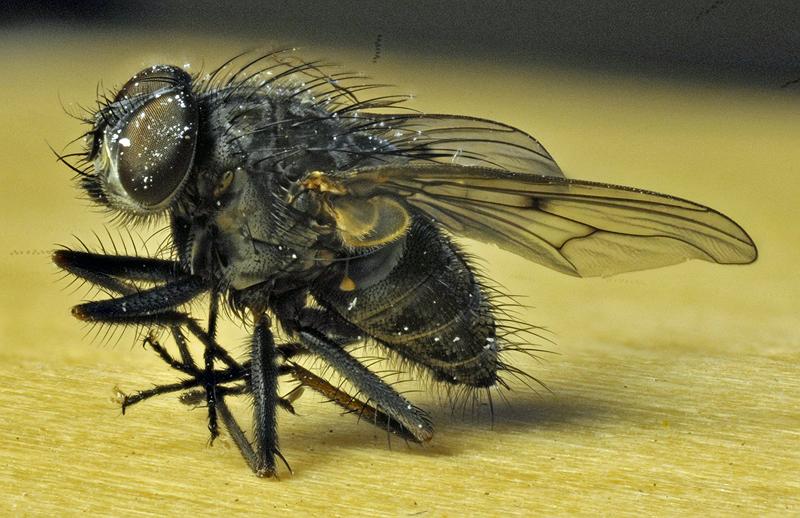

|
|
Tipula paludosa: European Crane Fly adults exist entirely to reproduce and are incapable of eating. Their
larvae eat grass roots, as do those of our native Tipula species.
| |
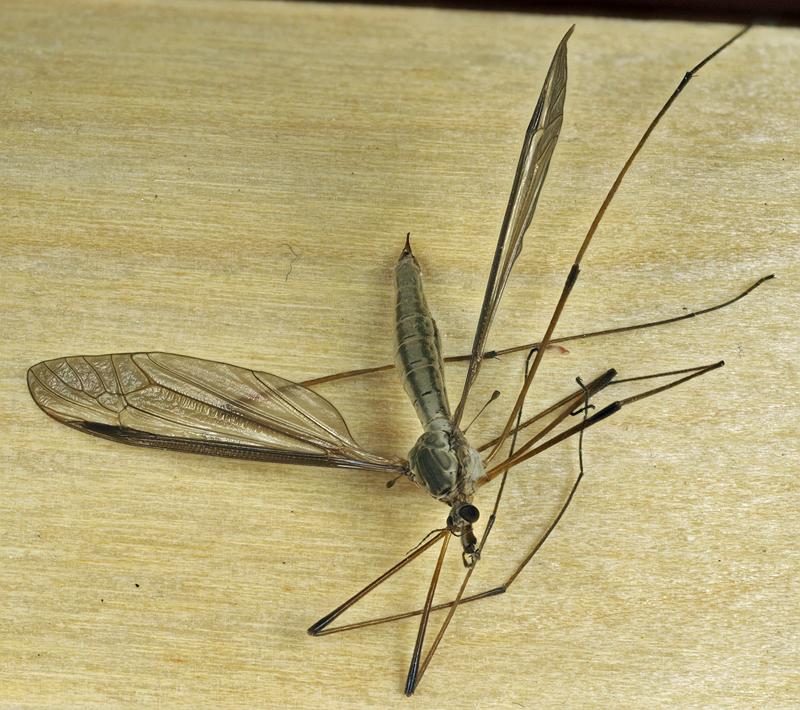

|
|
Toxomerus marginatus: This is a common small syrphid hover fly that varies considerably in
colour depending on the temperature experienced by the larva. It bobs its flattened abdomen about
twice per second to mimic stinging Hymenoptera; its larvae eat aphids and thrips. Length 5 mm.
| |
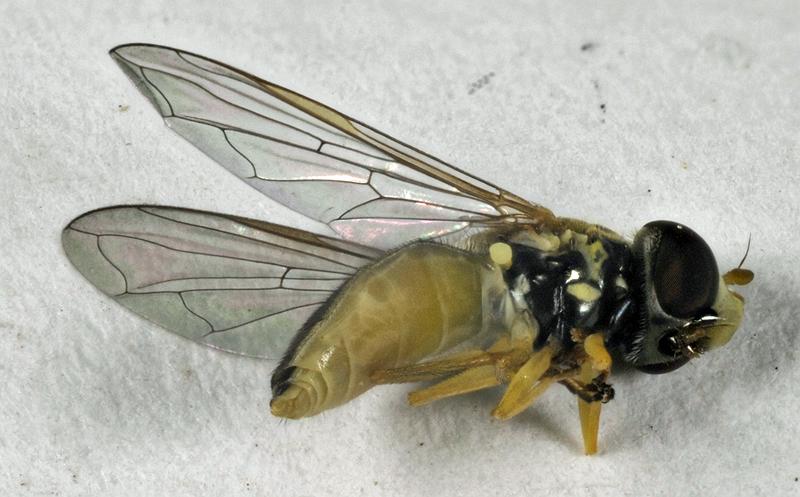

|
|
Trichocera: These small crane flies fly in colder weather than most others, earning them the nickname
winter crane flies. Their larvae live in rotting vegetable matter. Length 6 mm.
| |
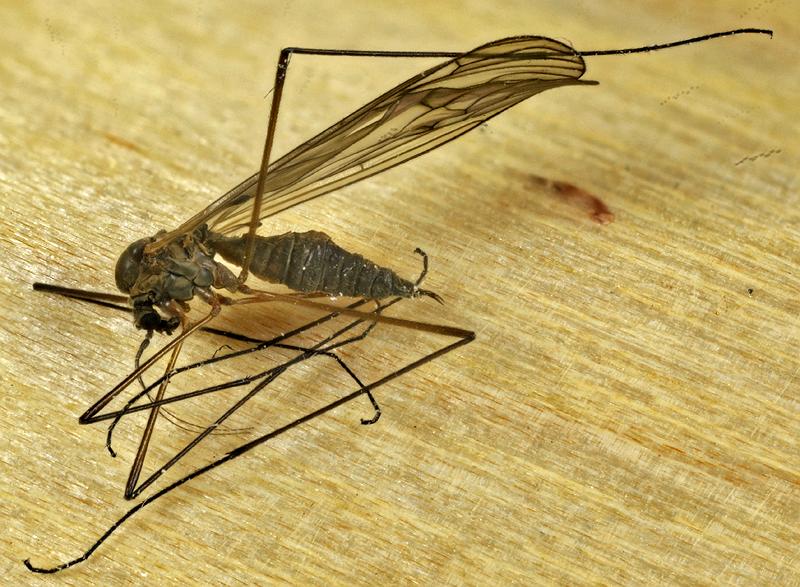

|
|
Zodion cinereum: These flies mimic stinging Hymenoptera, females attack them in flight and insert an egg between
the wasp's abdominal segments that then grows as an internal parasite of the wasp. Length 7 mm.
| |
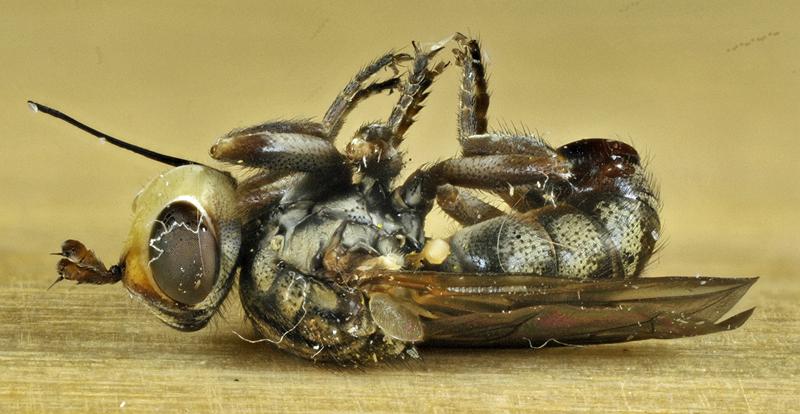

|
|
Zygoneura: Fungus Gnat. Length 1.8 mm.
| |
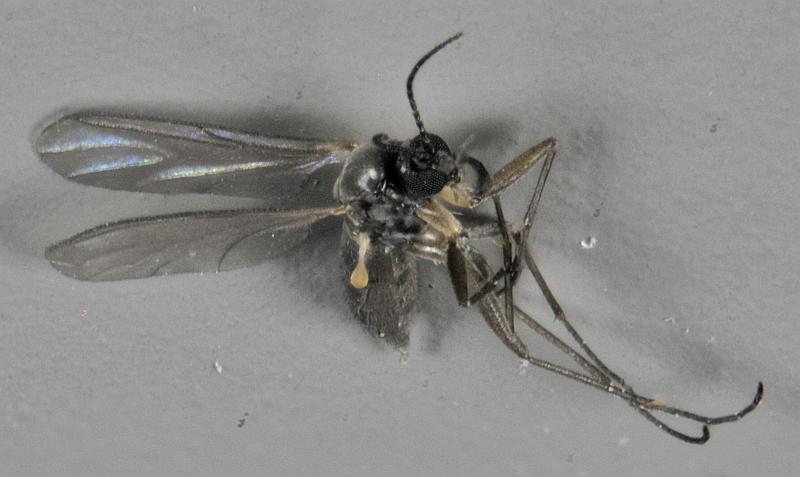

|































































































































































































































































